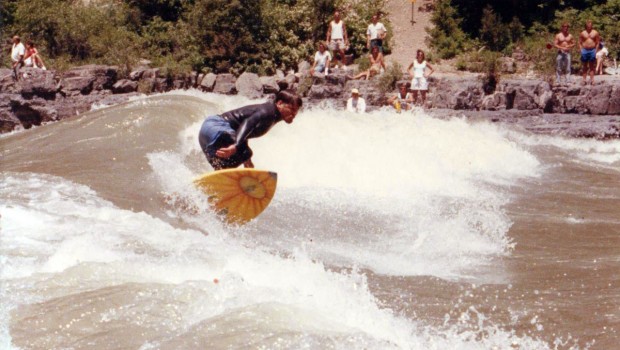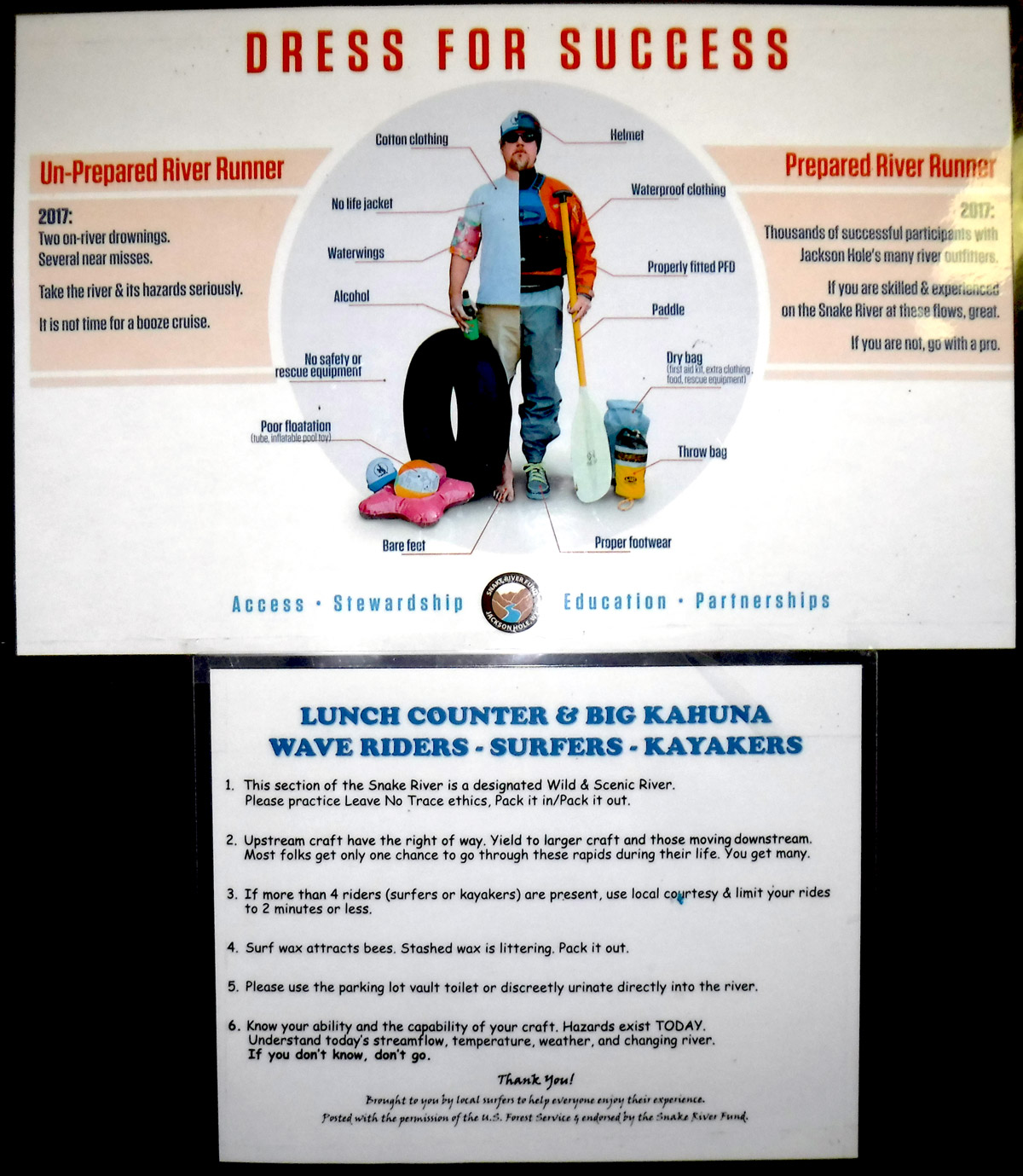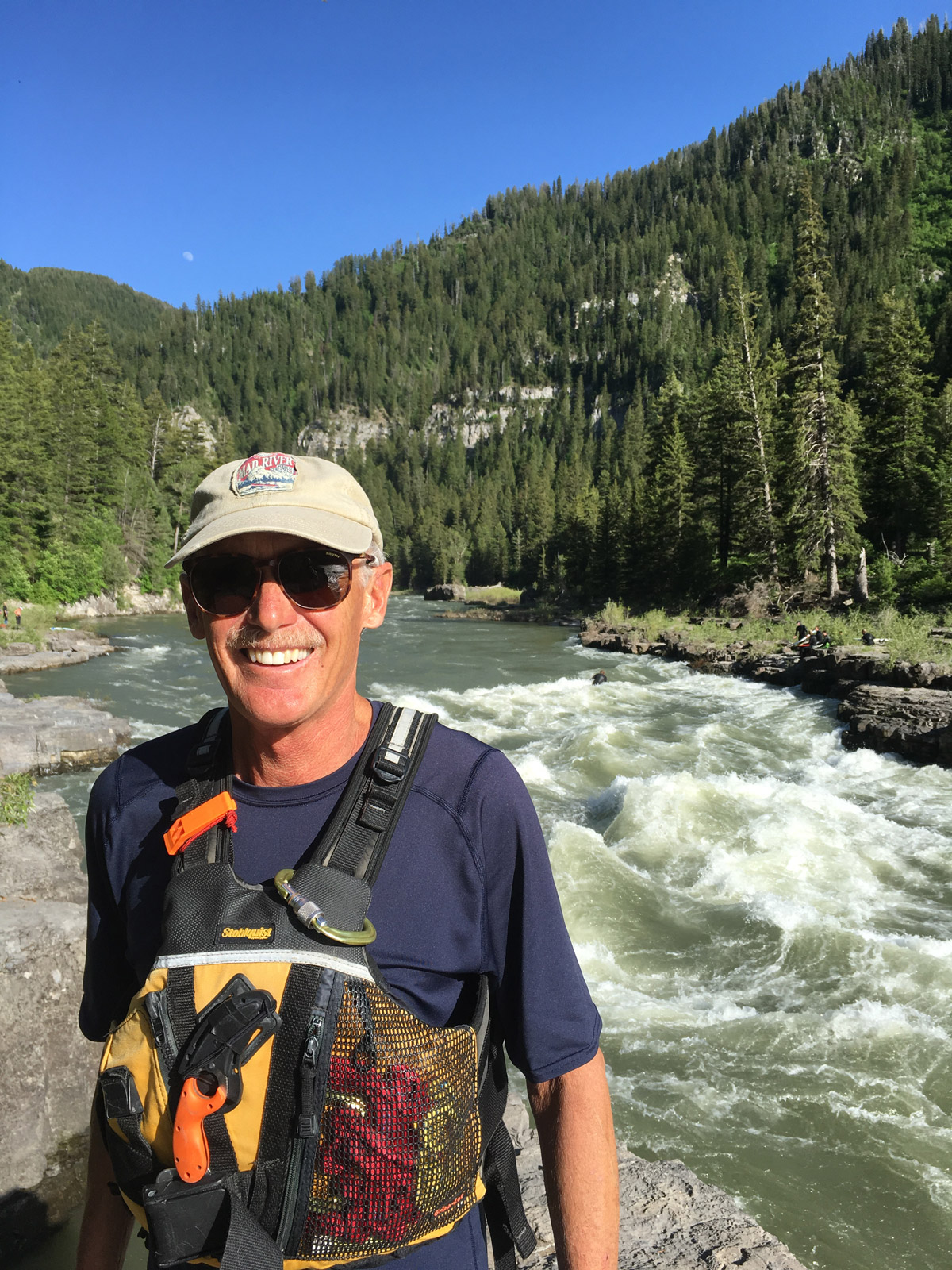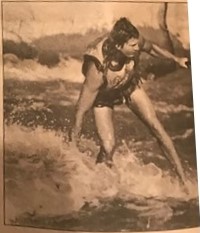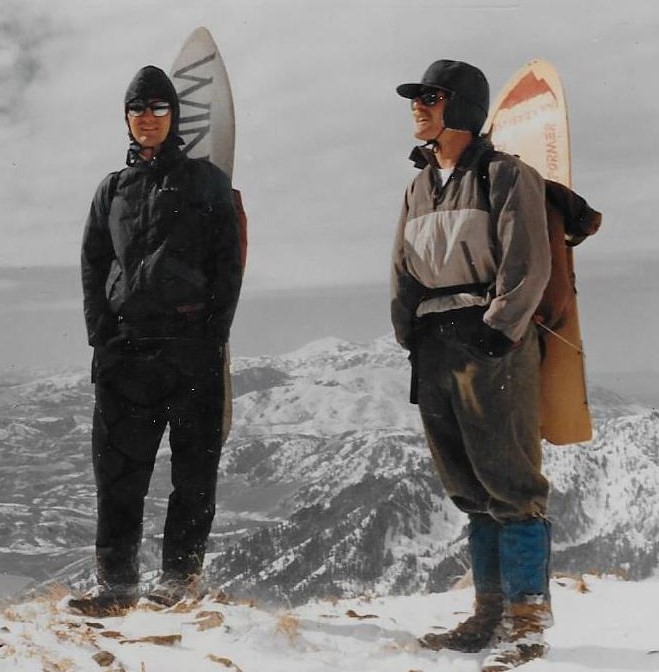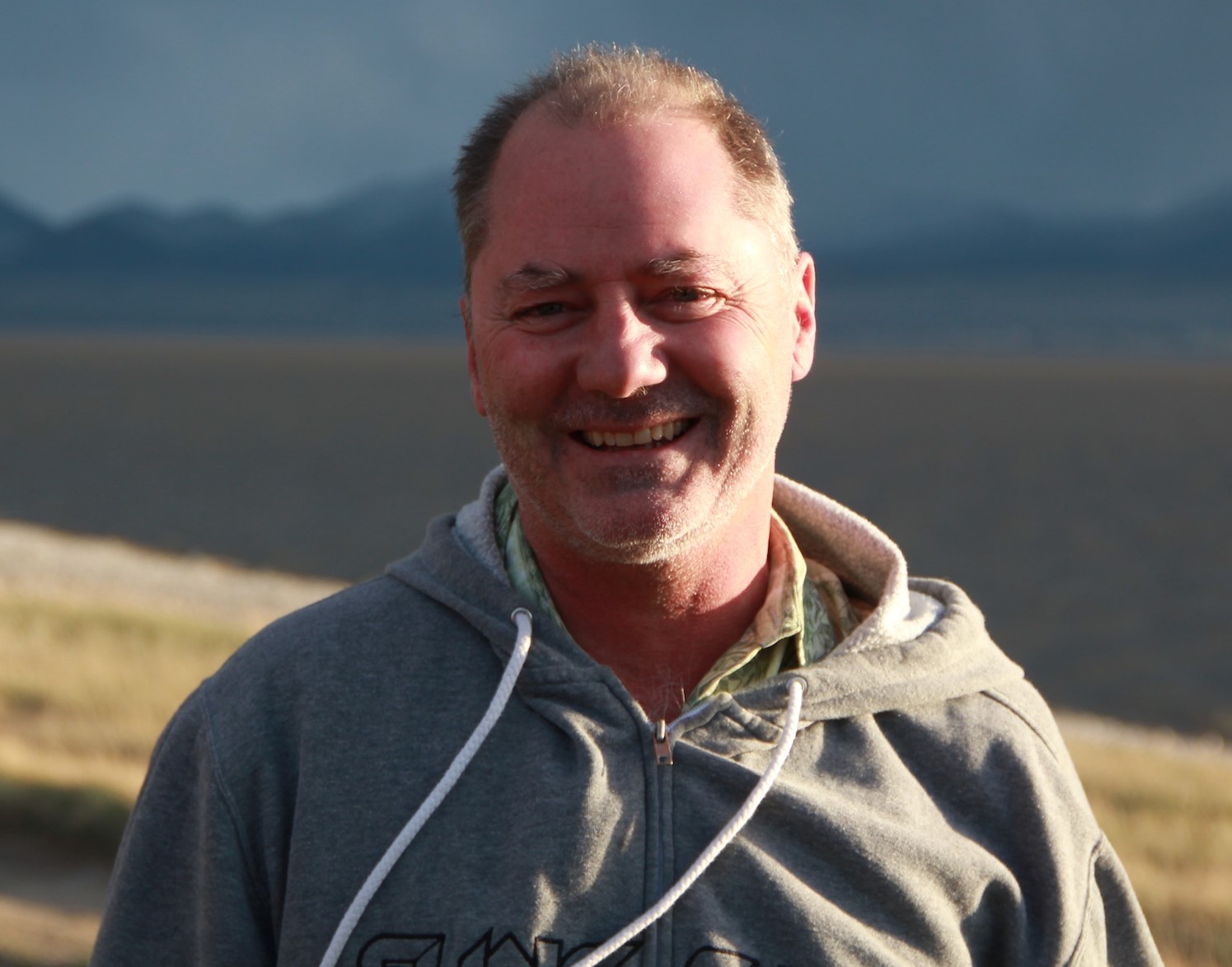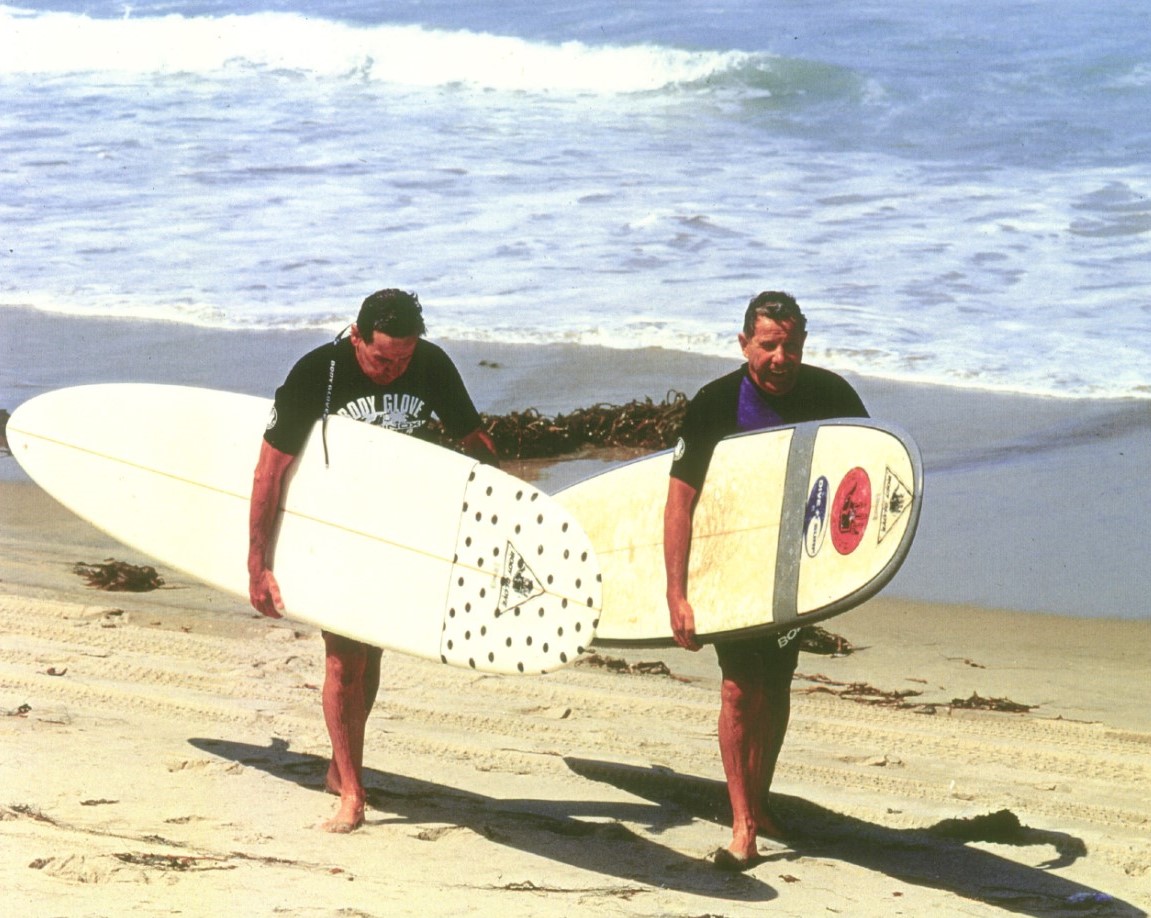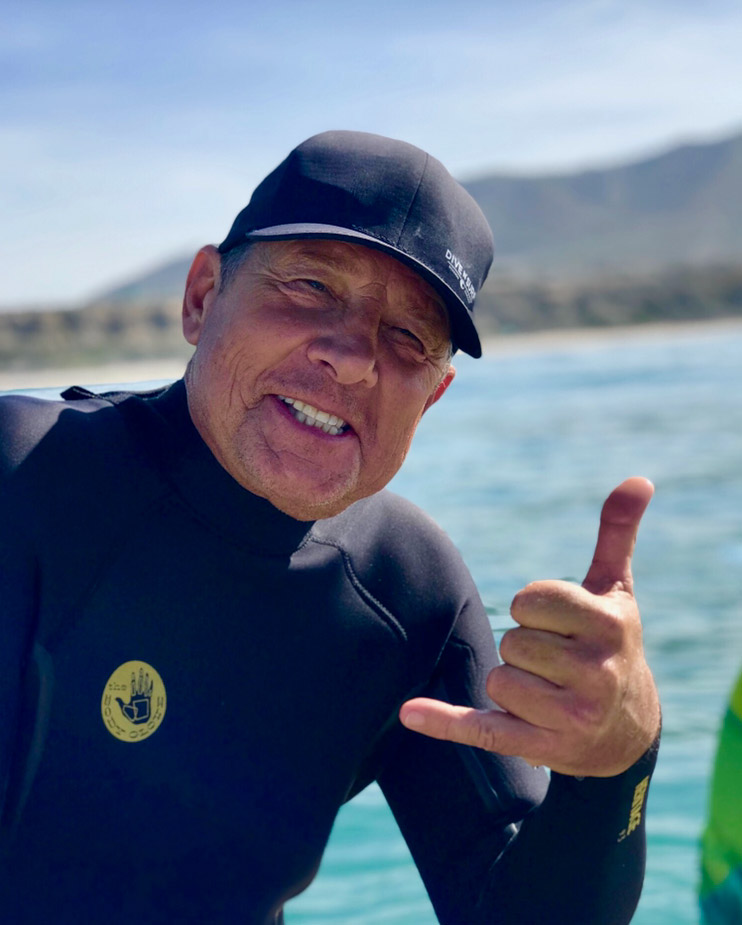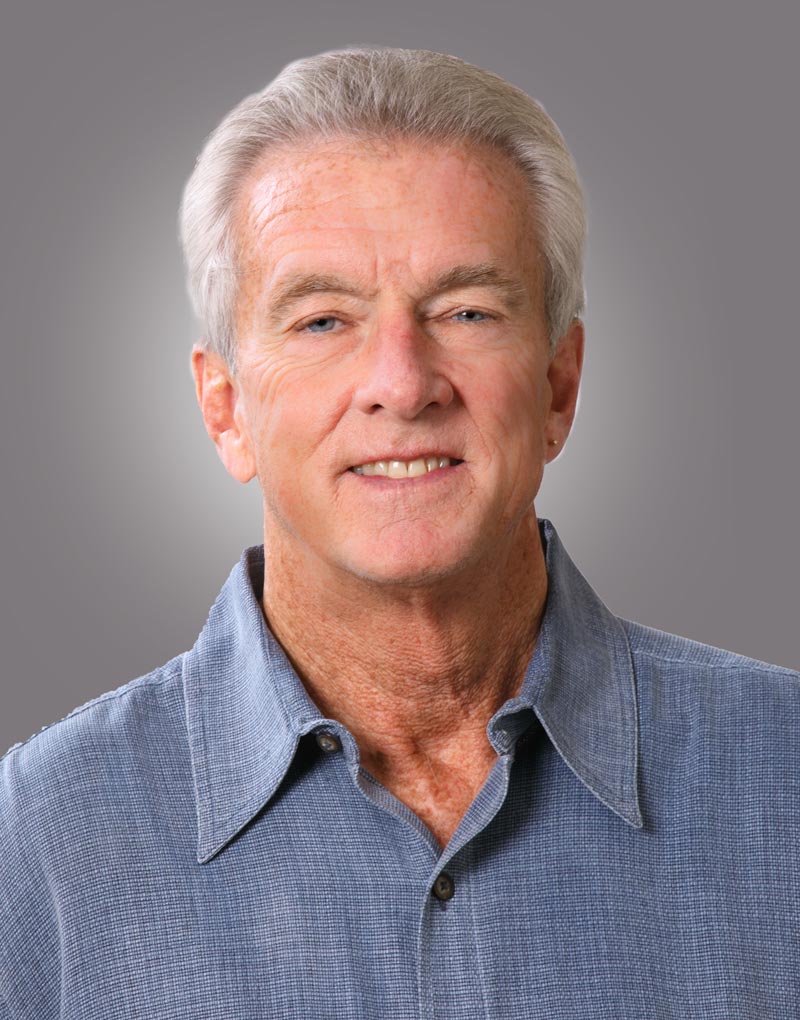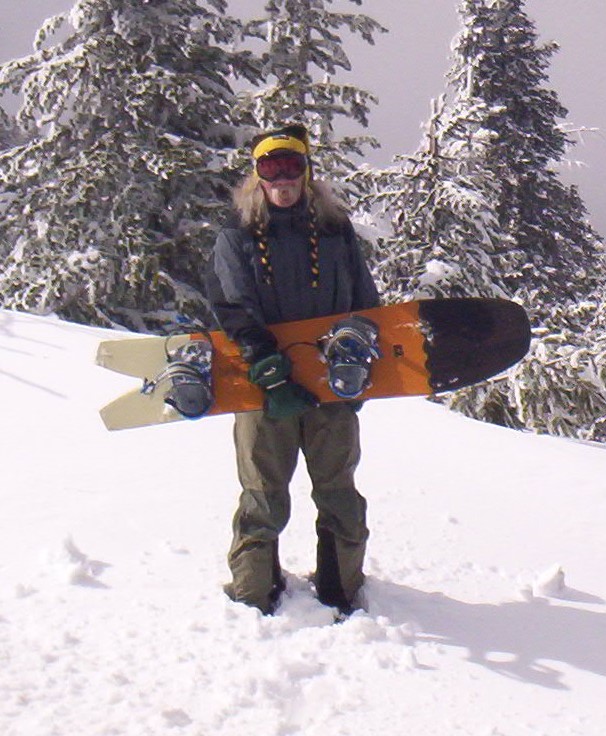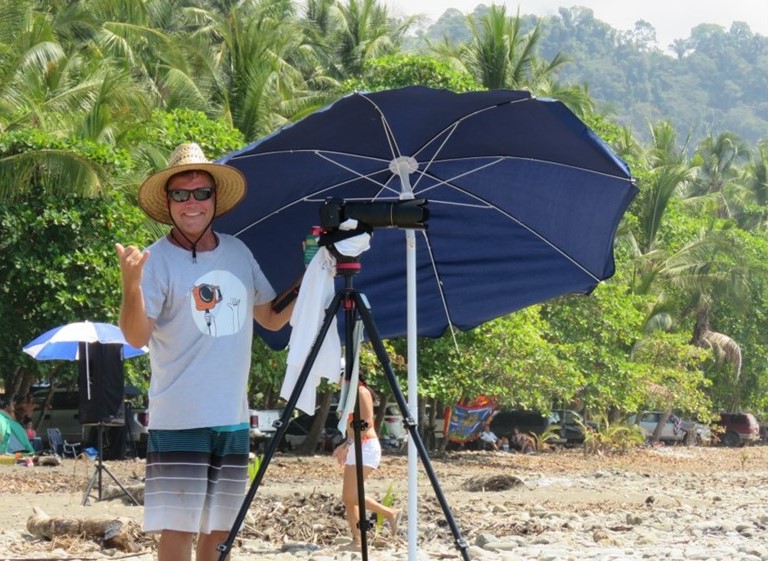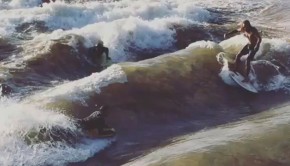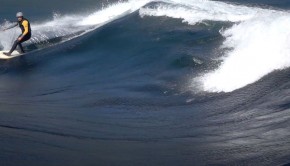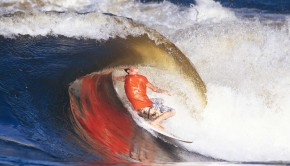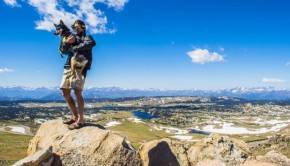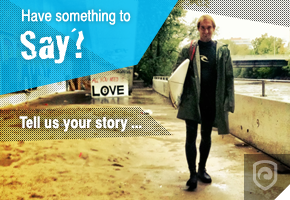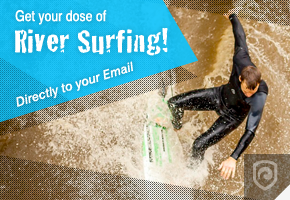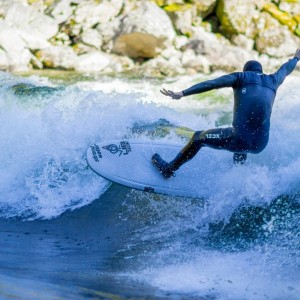The History of River Surfing in North America: 1975 to 2000
Prologue
The word “history” is derived from a Greek term denoting knowledge acquired through investigation. Although there will always be unsung people and untold stories, the history of river surfing in North America at the end of the 20th century has remained largely unexplored. This article is not intended as a comprehensive description of people, places, and times that many may regard as water under the bridge. Rather, it seeks to identify and celebrate those who went first, insofar as we know. It revels in early promotions, outtakes, in-between stories, and the lesser known but crucial beginnings of a late 20th century river surfing renaissance that occurred in North America.
This article seeks to identify and celebrate those who went first, insofar as we know.
Stories and commentary in surfing- and sports-media have long branded 20th century river surfers and their accomplishments as “novelty” or “not broad-spectrum”. These are especially troubling word choices, because they whitewash groundbreaking contributions that were pivotal to river surfing history. A recent din of solipsistic crowing and sycophantic accords among contributors to the river surfing press seems intent on further eroding the accomplishments of those who preceded them. Equally troubling are narratives that equate postmillennial river surfing personalities with ocean surfing’s foremost pioneers. Such comparisons pervert the fact that those same individuals came to river surfing after seeing someone in our cohort doing it. They are akin to a leaf detached from its tree.
In the mid- to late-1990s young people began embracing alternative sports competitions like the neoteric X-games. Snowboarding debuted at the 1998 Winter Olympics in Nagano, Japan. The world’s attention turned to the action sports, bringing the generation that pioneered the lifestyle no small bit of satisfaction. By the turn of the century only half of North American adults had yet tapped into the internet. Progress since has opened new windows for the recognition and promotion of the sport of river surfing that 20th century river surfers simply did not have. That people capitalized on those new opportunities is commendable, but what our generation achieved without those advantages is definitively historic.
Locals Rule!
Transient surfers on passing sorties are dependent on those familiar with local rivers to enable their successes. Stationary river features have long been the exclusive play-spots of white-water rivercraft. When we river surfers claim to be the first to surf a river wave, it is with the full understanding that white-water boaters have been surfing those same features for decades, and in some cases, they were surfed for centuries before us.
Communities of river sports enthusiasts spring up around good waves, and community is everything.
Locals, traditionally the river runners, but progressively generations of river surfers, understand how to access, enjoy, and safely exit river waves. They know local rivers in all seasons, water levels, weather conditions, and complexities. They are there for big water spring runoffs, midsummer play days, and enduring low-water conditions. They watch out for the safety of the less-experienced. They develop complex relationships across years of shared sessions and uncommon adventures. They transmit local knowledge, techniques, and style. They tell and retell local stories. They build river cultures that enhance river environments and boost local economies. Communities of river sports enthusiasts spring up around good waves, and community is everything.
LOCALS RULE! ”They watch out for the safety of the less-experienced”. Kayaker Dennis Wills pulled this distressed body boarder into the eddy above the Lunch Counter in 1988, but when the current turned perilous it was determination, communication, and collaboration that got her safely ashore.
Addendum
There have been longstanding differences between some river surfers and other river sports enthusiasts about the importance of Personal Floatation Devices (PFD), helmets, and the risks associated with surfboard leashes. PFDs in earlier eras were especially bulky and unwieldly. They hindered surfers’ ability to remain stable on top of their surfboards while paddling in hazardous conditions. This article is rife with historical images of river surfers with little or no safety gear in sight.
The collective answer was for surfboards to act as our floatation, and we relied on being tethered to them. Very few of us wore helmets. These were not the right solutions. I myself very nearly drowned when my leash failed and I was separated from my surfboard. River surfers have drowned when their ankle leashes became entangled. They can suffer traumatic brain injuries from impacts with their surfboards, fins, bottom features, and river debris. Testaments on the importance of appropriate safety gear can be found here and elsewhere.
Snake River, Wyoming 1978
North American river surfing history traces very precisely through Mike “Fitz” FitzPatrick, Steve Osman and Steve Hahn, who first surfed the Lunch Counter wave on the Snake River in 1978. Their shared experiences as whitewater river guides and kayakers meant they understood surfing the Snake River’s abundant holes and waves. Varying degrees of ocean knowledge helped them to foresee the Lunch Counter’s board-surfing potential. Fitz says that they had no knowledge whatsoever of river surfing having arisen anywhere else.
Fitz and Osman’s conversations about whether Lunch Counter was board-surfable began as early as 1976, but neither had the necessary equipment to give it a try. Unfortunately, 1977 was a particularly dry water year, and there was little opportunity or motivation to test their theory. River levels in 1978 were considerably more generous. That year the river ran in the 8,000 to 13,000 cubic-feet-per-second (cfs) window that the Lunch Counter wave requires to be surfable throughout the month of July.
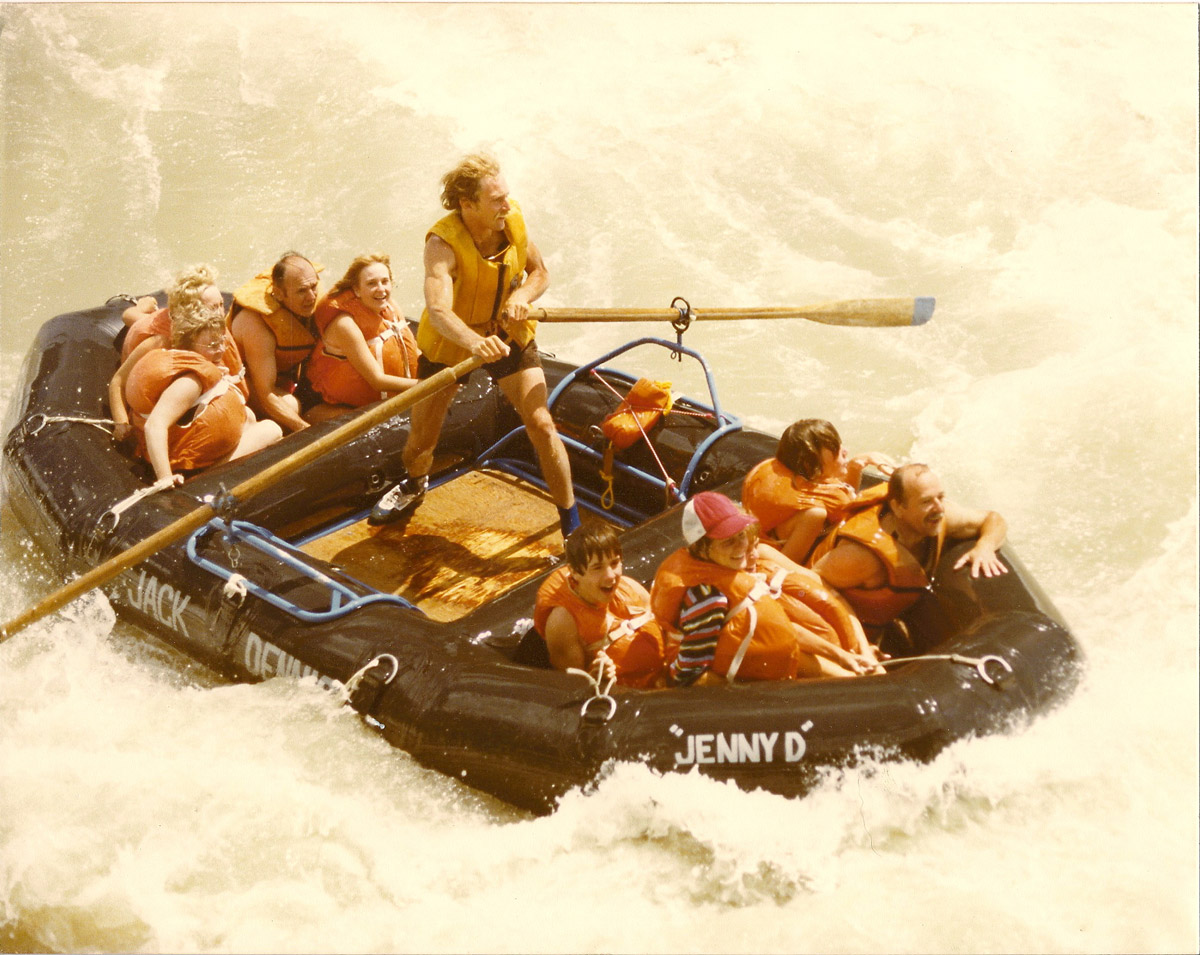
Mike “Fitz” FitzPatrick guiding a commercial raft through the Lunch Counter in the summer of 1978. (Photo: Float-o-Graphs)
That same year, an acquaintance guide working for another river running company, Steve Hahn, returned from a trip to California with a surfboard. Hahn was the first to attempt surfing the Lunch Counter, but a lack of surfing experience prevented him from mastering it on his own. Fitz and Osman asked if they could join him in challenging the wave together. The trio lingered on the river one afternoon after work, and then assembled at the Lunch Counter to try their luck.
FitzPatrick became the very first North American river surfer.
Starting below the now long-gone Lunch Counter roadside pullout (river right), they all took their turn putting in, paddling Hahn’s surfboard across the channel, and backing into the wave. Each managed to catch and ride the wave prone that first session, but standing proved elusive. Then Fitz leapt to his feet and did a series of rollercoaster turns for about thirty seconds. In so doing, he became the very first North American river surfer. A riverside professional whitewater photographer working for Float-o-Graphs out of Jackson, Wyoming captured FitzPatrick’s historic 1978 first ride in the two pictures posted here. Fitz recalls that it took several more sessions before his companion surfers were able to join him up-and-riding.
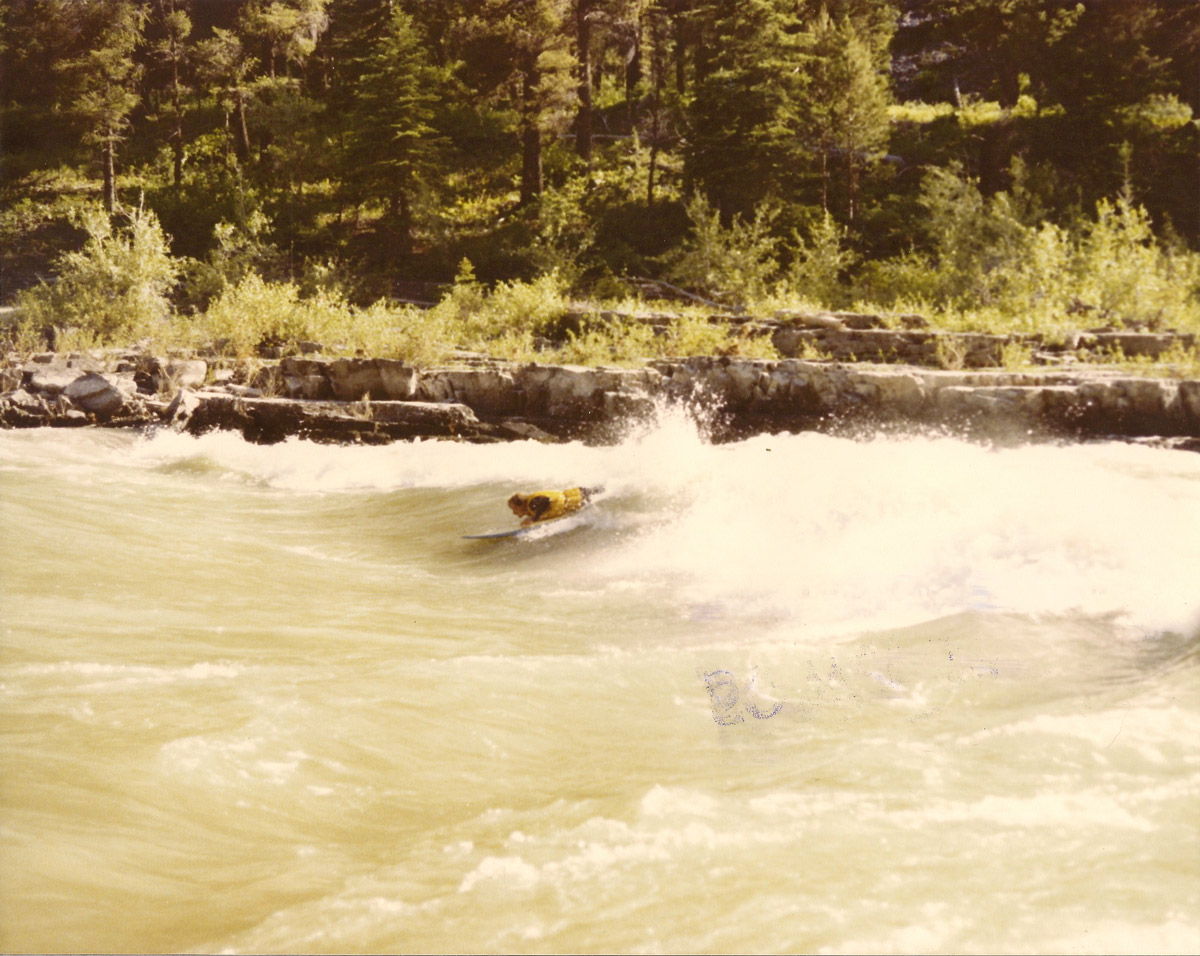
Mike “Fitz” FitzPatrick sets up his takeoff on the first ever North American board-surfed river wave on the Lunch Counter in July of 1978. (Photo: Float-o-Graphs)

Mike “Fitz” FitzPatrick up-and-riding on the very first ever North American board-surfed river wave on the Lunch Counter in July of 1978. (Photo: Float-o-Graphs)
The three of them continued to board-surf the Lunch Counter for years thereafter. Fitz purchased a 7’6” Caster singe fin gun of his own to surf the wave. They began to put the word out about what they were doing and to share photographs. In time, a river surfing picture taken at Lunch Counter found its way into Outside Magazine, at the time a brand-new and very popular American periodical focused on outdoor lifestyles. River surfing had gained national exposure.
Fitz originally learned to surf at Higgins Beach on the East Coast of Maine. After brief stints surfing in California and Hawai‘i, he took a sailboat trip to Tahiti. According to Fitz, surfing at Huahine in French Polynesia significantly improved his surfing abilities.
A heartfelt video interview of Mike and Cam FitzPatrick by Ryan Dorgan is imbedded in an article by Clark Foster in the September 2018 Jackson Hole News and Guide. It celebrates over 40 years of river surfing history on the Snake River. An interesting aside at the very beginning of the film is drone footage showing a river surfer setting up a takeoff on the Big Kahuna rapid. The Lunch Counter can be seen downriver in the distance.
Interview with Mike and Cam FitzPatrick by Ryan Dorgan in Clark Foster’s article in the September 2018 Jackson Hole News and Guide. (Photo: Jackson Hole News and Guide)
Mike FitzPatrick is 71 years old, happily married to his delightful wife Lee, has one adult son, Cameron, and still lives within a few miles of the town of Jackson. He last surfed the Lunch Counter at the age of 67 in 2015. A shoulder injury and replacement surgery have forced him to shift his spring and summer recreations to whitewater cata-rafts, standup paddle boarding, and other pursuits associated with an active lifestyle in the Intermountain West. In winter, his focus parks squarely on alpine skiing at Jackson Hole Mountain Resort (JHMR), along with some alpine ski touring in the surrounding backcountry. Fitz has been on the Ski Patrol for over 25 years, and he still works for JHMR as a ski-patrol dispatcher. He is responsible for various organizational tasks on the mountain, including coordinating field emergencies.
Fitz’s only son Cam rips the Lunch Counter every surfing season, is a highly regarded professional snowboarder, and a sponsored athlete for JHMR. Cam has skied at JHMR since he was two, and among his accomplishments of late is being a featured JHMR snowboarder in the 2019 Warren Miller Entertainment 70th Film entitled “Timeless”. The film references his family history at JHMR, and includes a clip of his dad on the mountain in winter.
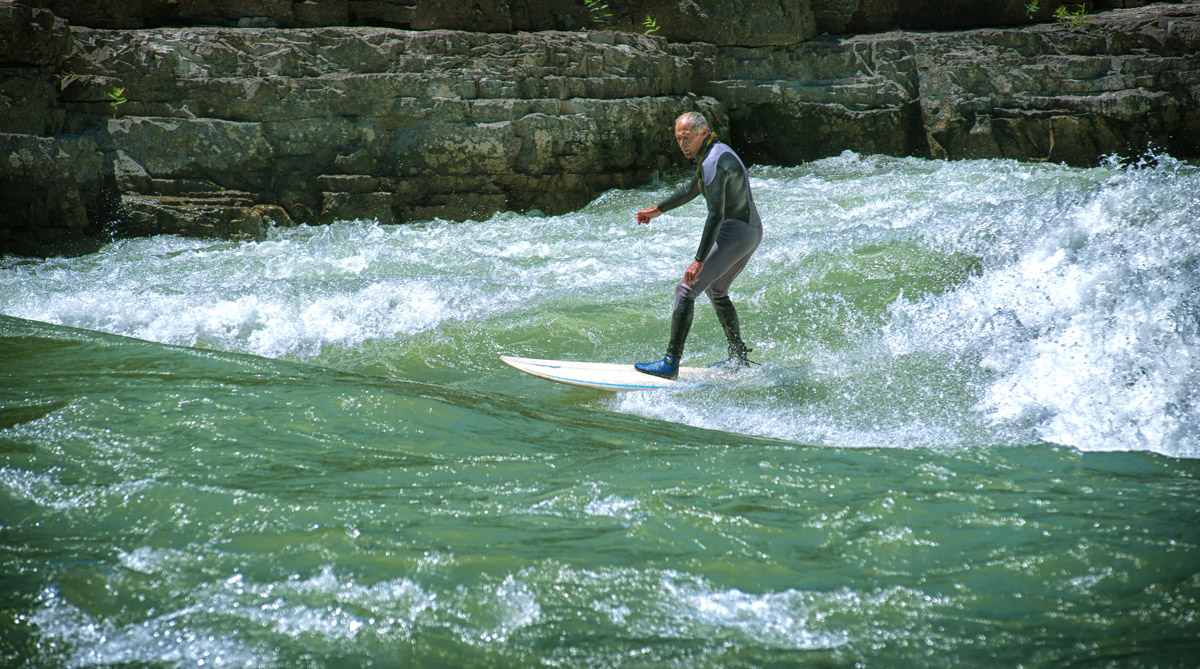
Mike “Fitz” FitzPatrick surfing at Lunch Counter shortly before his 65th birthday in 2013. (Photo: Float-o-Graphs)
Steve Hahn passed away in 2018 truncating the stories that he might have shared, but certainly not his pioneering accomplishments. He was a skilled whitewater guide for Snake River Park back in 1978. He was a very accomplished whitewater kayaker and alpine skier throughout his life. Steve owned a very successful masonry contracting business and lived in Jackson Hole until his passing.
Steve Osman and his family moved to Costa Rica in 1989, opening a naturalist touring business on the Pacific Coast. They specialized in white water rafting, sea kayaking, and naturalist trips. In 2000 they returned to the USA and settled in Bozeman, Montana. During his decades in Big Sky Country he has worked as a fly fishing guide, restauranteur, and marketed his fine art works as Steve Osman Fine Art. Besides painting, Osman continues to enjoy skiing, fishing, and family time with his grandchildren. This 2018 Mountain Journal article chronicles some of his good works.
Jordan River, Utah 1983
Possibly the first organized North American river surfing competition was held on Utah’s Jordan River on June 14, 1983. The Jordan River Hole Riding Contest was organized by kayakers, who opted to include a surfboard division. Hyrda Kayaks, Raccoon Productions, and Class VI Whitewater sponsored the event. A raffle associated with the event raised $275.00, a nice sum of money at that time for the America Rivers Conservation Council. In the surfboard division Ron Orton took first, Tony Logosz second, and Pedro Armington took third.
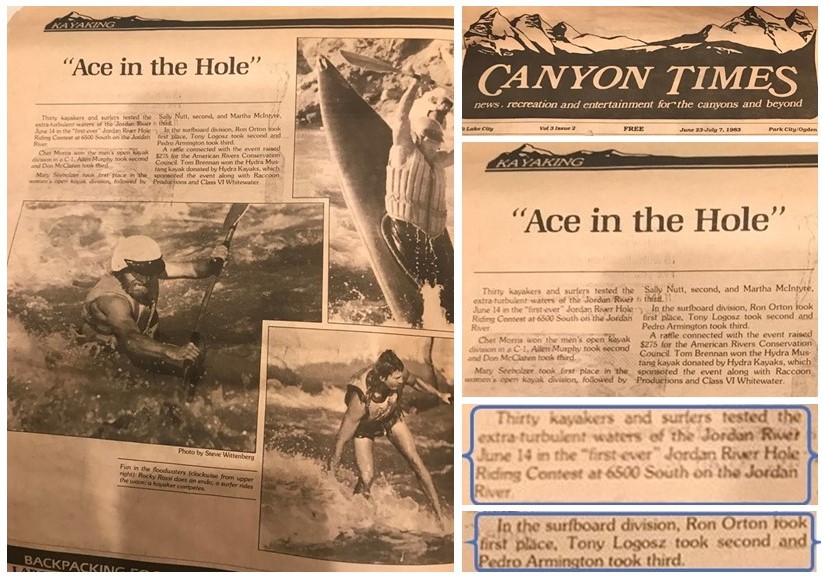
June 23 – July 7, 1983 Canyon Times article on the Jordan River Hole Riding Contest. Tony Logosz is shown up and riding. (Source: Ron Orton)
According to Ron, “The (Jordan River Hole) wave was the result of the thaw of the epic powder we snow surfed during the legendary 82/83 season in the Wasatch Mountains. The following spring flooding mitigation efforts included an excavation downriver of a bridge that produced a fun standing wave that we would ride pretty much every day after work. Although it was possible to get on the wave from the bridge wing wall, it was easier to use a rope to catch it, and then toss the rope and work the wave.” Regulars on the Jordan River Hole included Ron Orton, Tony and Jeff Logosz, and a couple of Hawaiian men. Although Ron does not recall the men’s names, he remembers that they showed up rockin’ a bright green 57 Cadillac with gold bumpers. Both worked for Delta Airlines and were transferred to Salt Lake City from the Islands. One has to wonder if they had knowledge of or had ever river surfed in Hawai‘i prior to that time.
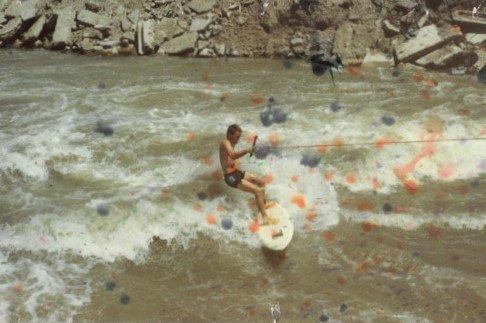
Only known photograph showing the Jordan River Hole setup in 1983. Note the rope that river surfers typically used to catch the wave. (Source: Don Piburn)
An aside about the Jordan wave was how when Ron was done surfing or fell, he would sometimes hold his surfboard flat and the current would take him down to the bottom of the hole, which he describes as “pretty deep based on the pressure I felt on my ears”. Before he reached the bottom, he would tip the board sideways which brought him back to the surface. In hindsight he suspects, “It might not have been the smartest thing to do, as I could have been pinned”. Ron came by his audacious spirit by linage. His great grandpa would swim the rapids on the Snake River back in the 1920′s, and people thought he was crazy. Ron added, “Apparently if he would get stuck in a hole, he would crawl out of it”.
Ron surfed the Lunch Counter in big water back in 1995. He recalls it was a weekday in the month of June. Nobody was around except for his wife Michelle, who was sitting on the roadside bank with their infant and toddler. While attempting to paddle across, Ron was swept the length of the rapid. He climbed out way downriver by the third eddy along the far bank (river left). He had to break trail through the dense forest with a surfboard under his arm all the way back to the Lunch Counter. The river flow was on the high side, and much of the time the wave was washing out. It was especially hard to catch it on his 5′ 6” Rusty Preisendorfer Canyon shortboard. After multiple attempts, he managed to catch and surf the wave. He was exhausted, all alone in big water, and his wife was seriously concerned for his safety. It was a short, but none-the-less eventful session.
Ron Orton started backcountry “snowsurfing” on Guardman’s Pass in Northern Utah in 1979. He pursued river surfing not long after, and is still drawn to standing waves. An avid boardsailor since the early 80s, he channeled those skills into kitesurfing in 1999. He helped pioneer the sport of snowkiting in the United States, where his obsession is finding and riding the perfect wave—frozen and fluid. Ron primarily kitesurfs Montana’s uncrowded lakes, and snowkites the Rockies’ diverse terrain. A decade ago, he started a family-run, local kitesurfing business, Kites West, to support Montana’s local kiting community.
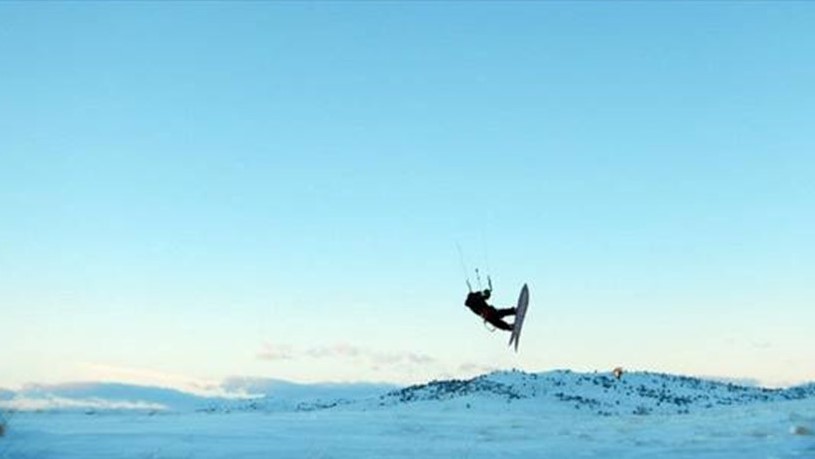
Ron Orton logging hangtime on his snowkite in 2015. (Photo: Ron Orton)
Snake River, Wyoming 1983 and 1984
In 1983 and 1984, professional surfer Steve Machin visited a childhood friend living in Jackson Hole for a white-water rafting and kayaking adventure on the Snake River. Just as FitzPatrick, Osman, and Hahn had before him, Steve recognized the board-surfing potential of the Lunch Counter. His buddy was from Hawai‘i and owned surfboards, so one day Steve asked to borrow one. He had no knowledge of other surfers having preceded him, and just assumed that he could figure it out.
The Lunch Counter is located at roughly the midway point of the West Table to Sheep Gulch section on the Snake River. That makes it a natural place for rafters and kayakers to pull out and take breaks. Many kayakers repeatedly portage their boats upriver to make cyclical runs through the Lunch Counter wave train. There were rafters and kayakers around when Steve first board-surfed the Lunch Counter, but there were no other surfers. It took a few tries, but he got to his feet during that first session. Steve was able to river surf the Lunch Counter multiple times during trips to Wyoming in 1983 and 1984.
Snake River, Wyoming 1985 and 1986
The Meistrell family of Body Glove International have longstanding business relationships and personal friendships with John Krisik and John Scott, executives at Life-Link International of Jackson, Wyoming. Croakies®, the original neoprene eyewear retention straps for outdoor enthusiasts, were invented by Jackson Hole resident Robbie Fuller. He repurposed scraps of spray-skirt material to secure his sunglasses in whitewater and on the slopes at JHMR. When demand grew, Fuller licensed Croakies® to Life-Link. Body Glove was the production center for Croakies® for many years. Krisik and Scott secured the patented manufacturing process, and began producing and marketing Croakies® themselves.
Krisik and Scott were also friends and river sports companions with first-ever North American river surfer Mike FitzPatrick. The Meistrells had heard of board surfing on the Snake River. In 1985 Scott and Krisik invited Body Glove to send members of their team of professional surfers and body boarders to surf the Lunch Counter wave.
Robert “Robbie” Meistrell, son of Body Glove co-founder Bob Meistrell, led that first trip in May of 1985. John Scott had extensive whitewater guide experience, so he coordinated the trip logistics with Robbie. Scott used contacts at the Jackson Lake Dam to monitor the expected runoff levels ahead of the trip to ensure that the Body Glove surfers would arrive when the Lunch Counter wave was breaking at its best. According to Robbie, they were all on standby until John made the call.
He recalls having to remember to breathe at first, because the rush of cold water literally took his breath away.
Robbie flew in to Jackson Hole Airport and met the safety and support boaters by arrangement. Body Glove Team surfers Jim Hogan and Brian McNulty drove a supply van full of camping and surf gear up from Southern California. Surfer Allen Sarlo and photographer and journalist Robert Beck flew in to Jackson on a later flight with plans to rally with everyone at the Lunch Counter, and later to camp with the team at a nearby Forest Service campground.
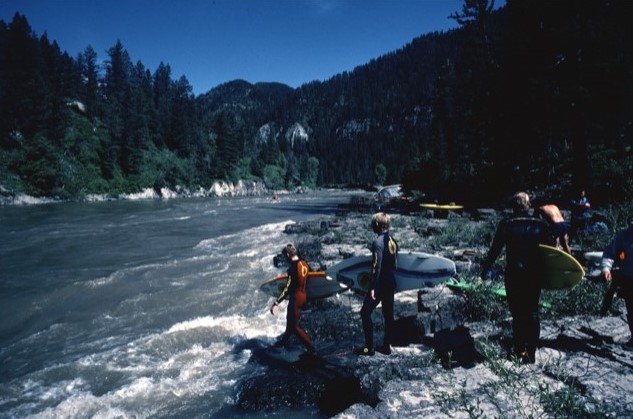
Brian McNulty, Jim Hogan, and unidentified surfer cued up on the first Body Glove trip to Lunch Counter in 1985. Note the tent, kayaks, surfboards, and all the support folks in the background (Photo: Robert Beck)
In 1985 Robbie Meistrell was first to test the Snake River waters on his body board. He worked his way up the roadside bank, put in, paddled across, and backed into the first wave of the trip. He recalls being more than a little startled by the sheer power of that much moving water. The Alpine Canyon section is melting snow not all that many miles upriver. Water temperatures hover around 39 degrees Fahrenheit in the month of May. According to Robbie, the wetsuits they brought on both trips were only 3/2 mm and used overlock seams, not the blind stitch and taped seams available in their 4/3 mm Body Glove suits. He recalls having to remember to breathe at first, because the rush of cold water literally took his breath away.
River surfing pioneer Mike FitzPatrick was on-board as a river surfing consultant for the 1985 Body Glove trip. He met Sarlo and Beck at the Jackson Airport, put their gear in his pickup truck and drove them straight to the Lunch Counter. Fitz says Body Glove had asked him to “show them the wave and how to get on it”, but when they got there Robbie, Jim, and Brian were already settled in and had been surfing the place for hours. Allen quickly suited up and joined the other surfers. Fitz joined the pros as well, surfing on his 7’6” Caster single fin. Body Glove gave Fitz a nice wetsuit as compensation for his efforts, which he still has to this day.
John Scott coordinated the safety and support boating for the Body Glove surfers in both 1985 and 1986. John Krisik ferried surfers, gear, and photographers to and from the far bank in a Lavro whitewater dory. Whenever surfers were up and riding, the safety and support boaters positioned themselves strategically along the Lunch Counter rapid. They were there to assist any surfers who missed punching the eddy line, got into any kind of distress, or were at risk of being dragged downriver. Scott described himself perched in his kayak atop a slide-in-rock just upriver of the Lunch Counter wave. Another boater was settled into the downriver eddy, ever ready to turn into the wave train at a moment’s notice if a surfer needed help.
In most cases when a surfer heard the warning blast, they would kick out of the wave to get clear.
One of John Scott’s suggestions for safety during the 1985 trip was for each person to take turns acting as a spotter armed with an airhorn and positioned some distance upriver. The river was in flood stage during the 1985 trip, and the experienced river guides knew that branches, logs, and even full trees can blow through on the current. The spotter’s blast was also helpful to warn the surfers of incoming rafts, because rafters were not expecting to have board-surfers riding the Lunch Counter wave back in those days. A vessel that is upriver of a feature has the commercially established right-of-way over a vessel in the feature. Thus, stationary surfers have to give way. In most cases when a surfer heard the warning blast, they would kick out of the wave to get clear.
Robert Beck was on assignment to photograph and capture the whole mission for Surfing Magazine. In addition, Beck recalls that his feature in Surfing generated sufficient interest to get picked up by Rolling Stone Magazine and the National Enquirer. River surfing had gained transnational exposure.
Later the next year, in October of 1986, Beck went to Hawai‘i to shoot the Ironman Triathlon with nothing but his camera gear and an airline ticket. There were no hotel rooms available, so he slept on a friend’s floor the first night. He checked in with the media center the day before the event and found out Sports Illustrated (SI) had “hired” him to shoot the race. He came out of that first assignment with a double truck table of contents picture for SI. The image became one of Life Magazine’s Pictures of the Decade. Over thirty years later he is still shooting sports, twenty of them as a staffer for SI where over 150 of his images have graced the cover.
Per his bio Beck has, “covered Gretzky and Bonds as they set lofty individual records, shot the Red Sox breaking curses, Kings winning crowns and a Tiger being chased by everyone. He’s had sittings with Peyton, Kobe, Shaq, The Flying Tomato, Tony Hawk, Magic, Floyd, Misty, Usain, Kersh, Neymar, Pele, Kelly, Steph, Baker, Montana and Michael (the swimming one) to name a few. World Series…check. NBA and Stanley Cup Finals … check. Super Bowls and BCS Championships … check. Final Four … check. Golf majors? Check to over 75 of them. And he has ventured to Beijing, Atlanta, London, Rio, Vancouver and Sochi to capture the emotion, color, pageantry and action that are the Olympic Games”.
We deeply appreciate Robert Beck so willingly sharing his photographs from the 1985 and 1986 Body Glove Lunch Counter trips for all river surfers to enjoy:

Allen Sarlo, Brian McNulty, Jim Hogan. Lunch Counter 1985. (Photo: Robert Beck)
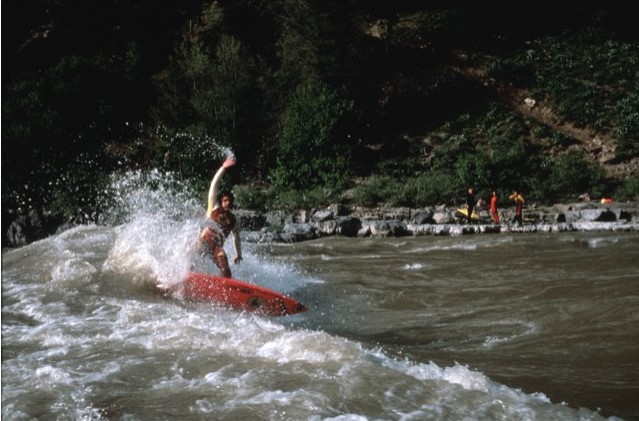
Allen Sarlo cutback. Lunch Counter 1985. (Photo: Robert Beck)

Jim Hogan cutback. Lunch Counter 1985. (Photo: Robert Beck)
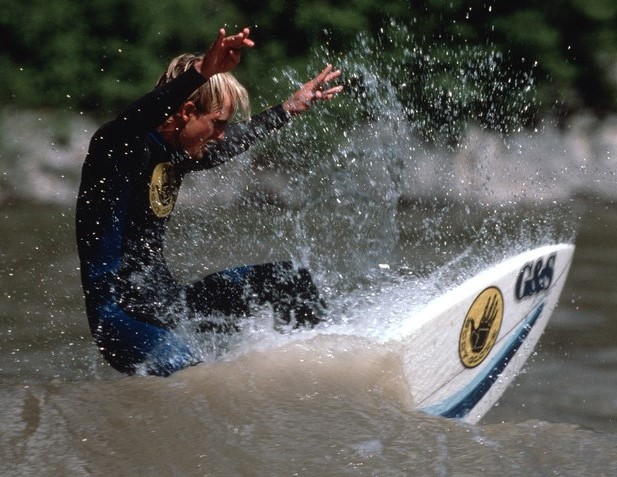
Jim Hogan snap Lunch Counter 1985. (Photo: Robert Beck)
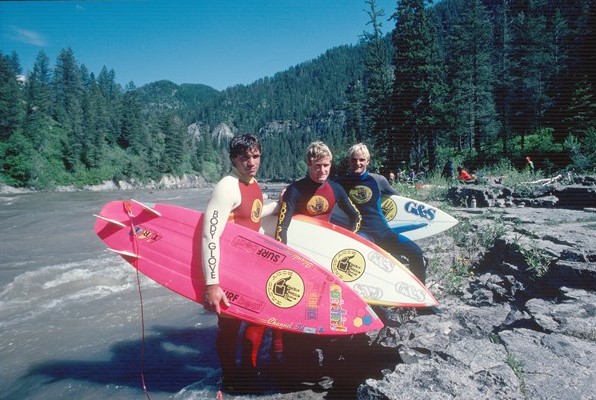
Allen Sarlo, Brian McNulty and Jim Hogan again. Lunch Counter 1985. (Photo: Robert Beck)
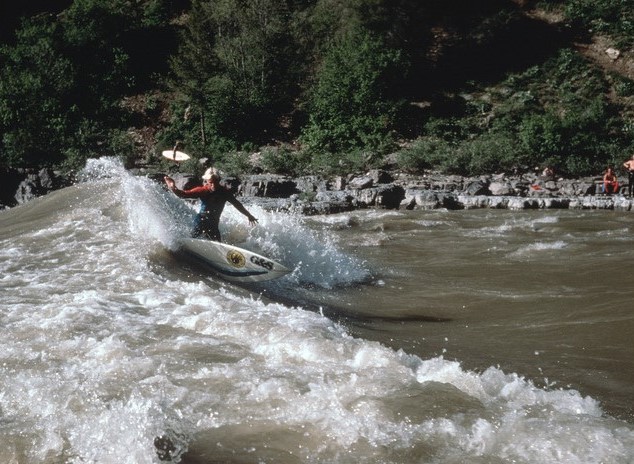
Jim Hogan cutback 1985. (Photo: Robert Beck)
The river during the1985 Body Glove trip was running at around 13,000 cfs, which is big, brown, cold, and powerful water. Although both mediums are immensely powerful, fresh river water does not behave like salty ocean water. The boards the 1985 Body Glove surfers brought did not offer quite the floatation that they were accustomed to in the ocean. This led some Body Glove surfers to select boards with extra volume for the 1986 trip. Managing heavy water in a river versus in the ocean are completely different skill sets. John Scott described the surfers as being a bit out of their element, at least until they were up-and-riding.
Their highest-level professional surfing delighted the Snake River locals and the riverside tourists alike.
All the surfers dialed the place in over the course of the day. Their highest-level professional surfing delighted the Snake River locals and the riverside tourists alike. Beck describes Robbie, Jim, Allen, and Brian absolutely shredding the place. Robbie enjoyed relating how his cutbacks would spray people sitting on the riverbank. Hogan figured out how to set his edge midface in a way that caused the wave to pitch and throw over him. McNulty was doing massive roundhouse cutbacks and whitewater rebounds. Sarlo was aggressively slashing upriver slip-faces.
If the surfers missed punching the eddy line and a kayaker wasn’t able to intervene, they would be washed down river. Beck described the lower wave train in big water as comparable to the same thrashing you’d expect on a 10-foot day at your local ocean surf break. You could end up anywhere from 200 yards to a mile downriver. When that happens, you can climb out on the roadside bank, scramble up loose scree to the road, and walk back along the highway with a surfboard under your arm. That would have garnered more than a few odd glances from drivers on the highway in those days. Alternatively, you could scale the steep bluff on the far bank and break trail through the forest back to Lunch Counter. By the second day the river level had risen and the wave became mushy. By the third day the river was running at 15,000 cfs, and the Lunch Counter wave was no longer surfable.
Some of the biggest names in professional surfing at the time absolutely shredding the Lunch Counter wave (Billy Meistrell).
The July 1986 Lunch Counter trip was led by William “Billy” Meistrell, son of Body Glove co-founder Bill Meistrell and Robbie’s first cousin. Billy explained that both the 1985 and 1986 Body Glove Lunch Counter promotions were all about the “biggest pros and flash.” Most wetsuits used by river runners of that era were available only in basic black or blue, that is until Body Glove surfing professionals came on the scene wearing bold, vivid, blazing color and neon. Billy described the atmosphere as, “Some of the biggest names in professional surfing at the time absolutely shredding the Lunch Counter wave.” The Body Glove trips formally introduced river surfing to the rest of the surfing world.
Surfers on the 1986 Body Glove Team included Scott Daley, Ted Robinson, and professional bodyboarders Danny Kim and Ben Severson. Daley explained that in 1986 the team flew in on day one, surfed until their legs were rubber on day two, and did their best to surf through sore muscles on the morning of day three. They all headed home later on that third day.
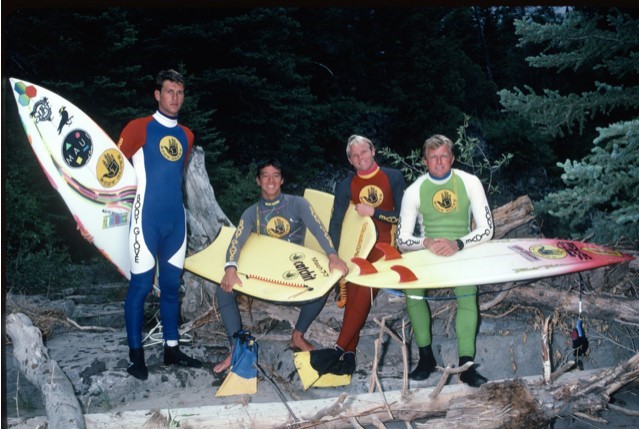
1986 Body Glove Team. Ted Robinson, Danny Kim, Ben Severson and Scott Daley. Lunch Counter 1986. (Photo: Robert Beck)
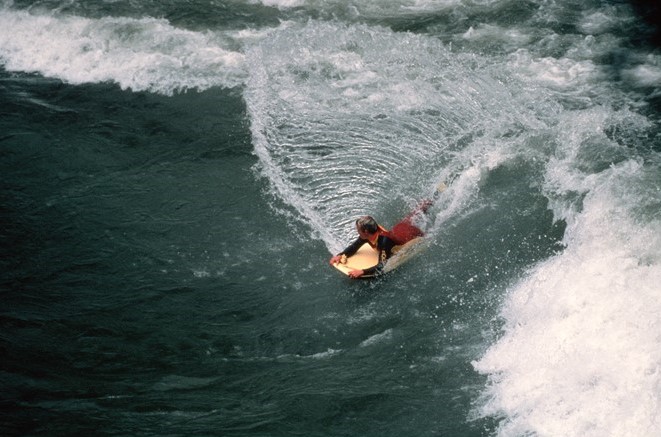
Ben Severson. Lunch Counter 1986. (Photo: Robert Beck)
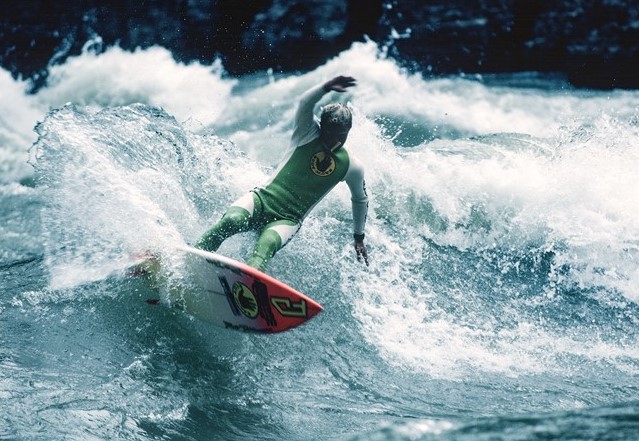
Scott Daley cutback Lunch Counter 1986. (Photo: Robert Beck)

Scott Daley. Lunch Counter cutback 1986. (Photo: Robert Beck)
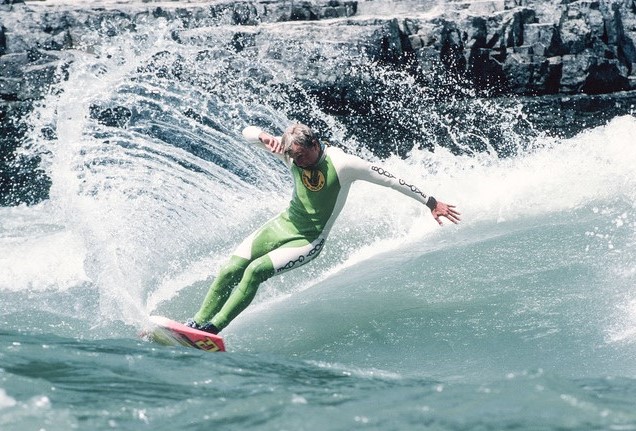
Scott Daley and fan. Lunch Counter cutback 1986. (Photo: Robert Beck)
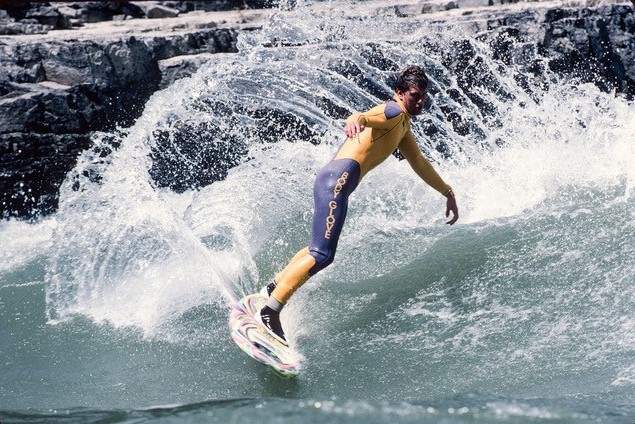
Ted Robinson. Lunch Counter 1986. (Photo: Robert Beck)

Ted Robinson and fan. Lunch Counter 1986. (Photo: Robert Beck)
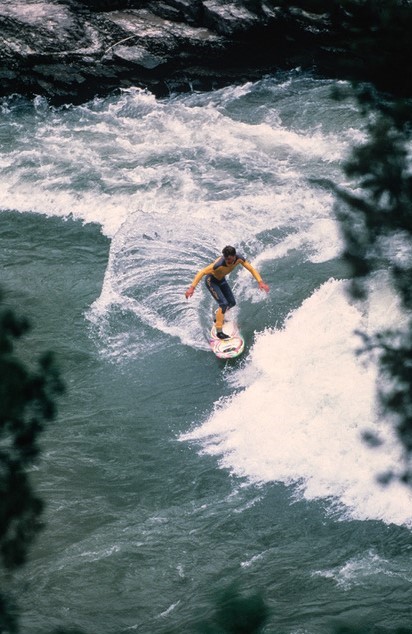
Ted Robinson cutback taken from the trail down. Lunch Counter 1986. (Photo: Robert Beck)
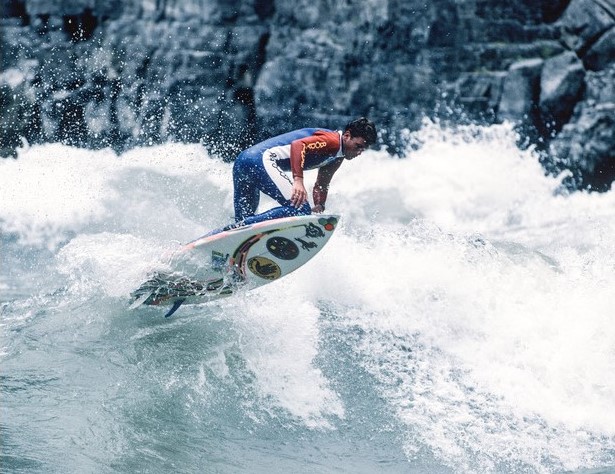
Ted Robinson fins-free. Lunch Counter 1986. (Photo: Robert Beck)
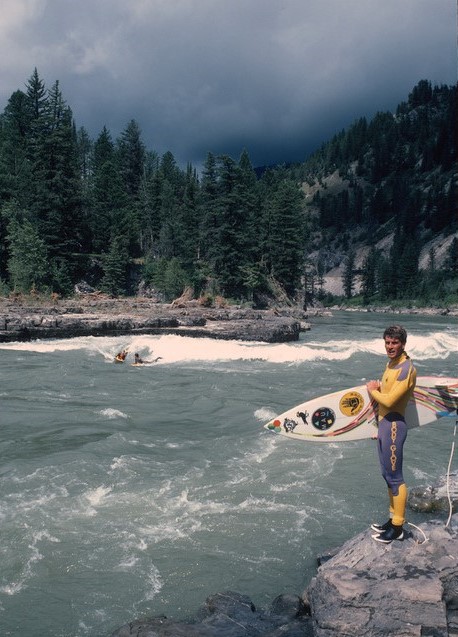
Ted Robinson, with Ben Severson and Danny Kim sharing Lunch Counter behind him 1986. (Photo: Robert Beck)
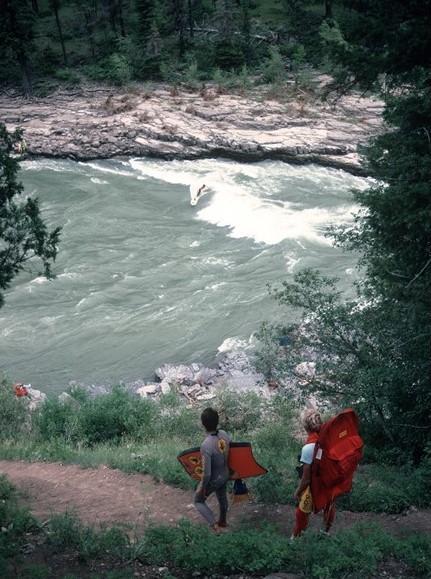
Danny Kim and Ben Severson walking down, with Ted Robinson surfing Lunch Counter 1986. (Photo: Robert Beck)
To this day Billy Meistrell calls John Scott his “Lifesaver”. When John tells the story, he suggests that it is just a long running and good-natured repartee between friends. Billy’s tenor is noticeably more serious. According to Billy, he somehow became separated from his body board, but managed to swim to the roadside bank. Finding himself on the opposite side than everyone else, he worked his way upriver several hundred yards and jumped in to swim across. In hindsight, he wishes that he’d have taken swimming in a flood stage river without floatation more seriously.
I too would surely have drowned, had my buddy Seal Morgan not jumped in and rescued me (DP).
Billy made it across the river, but near the far shore he missed punching the eddy line that is immediately upriver of the Lunch Counter. That momentary hesitation set him up to get flushed through the primary wave into the downriver eddy or possibly through the whole of the Lunch Counter wave train. Billy describes John Scott scrambling to the river’s edge and extending one of his legs out to give him something to latch on to. Billy is adamant that by offering up his leg and helping him to shore, John very likely saved his life. There is credence to his suggestion, given that a whirlpool forms in that downriver eddy where individuals have been dragged down and lost their lives. I myself can attest to the hazards of the Lunch Counter wave train, having once been separated from my surfboard and flushed through it without floatation. I too would surely have drowned, had my buddy Seal Morgan not jumped in and rescued me.
Severson was the reigning 1986 body boarding world champion at the time.
When Severson and Kim returned home to Oah’u in 1986, their new found river surfing skills transferred readily to the standing waves on the Waimea River. Severson was the reigning 1986 body boarding world champion at the time, having won the Morey Boogie Bodyboard Pro World Championship at Pipeline that January. Kim shared how over the many years that followed, the North Shore bodyboarding crew began opening up the beach pond during the annual Body Boarding World Championship contest period. Having the planet’s apex bodyboarders and select North Shore surfers collectively ripping O‘ahu river waves galvanized the respect for the Waimea River that carries through to the present day.
Body Glove co-founder Bill Meistrell passed away in 2006 and his twin Bob Meistrell passed in 2013. Bill’s son Billy Meistrell has worked full time for Body Glove since 1976. At 62 years of age, he now focuses principally on their retail Dive N’ Surf original location. Billy has been happily married to his wife Karin for 35 years. They have two grown children, Jenna and Daley. Bob’s son Robbie Meistrell was General Manager, President, and CEO of Body Glove International and Dive N’ Surf, Inc. between 1974 to 1983. He ran the Professional Surfing Association of America in the late ‘80s and early ‘90s. He is now retired at 68 years old and lives in the Palm Desert with his wife Nora. The business stayed in the Meistrell family for three generations. Two of the Meistrell grandchildren, Nick and Jenna Meistrell, still work for the company. Body Glove continues to make products for active outdoor enthusiasts internationally.
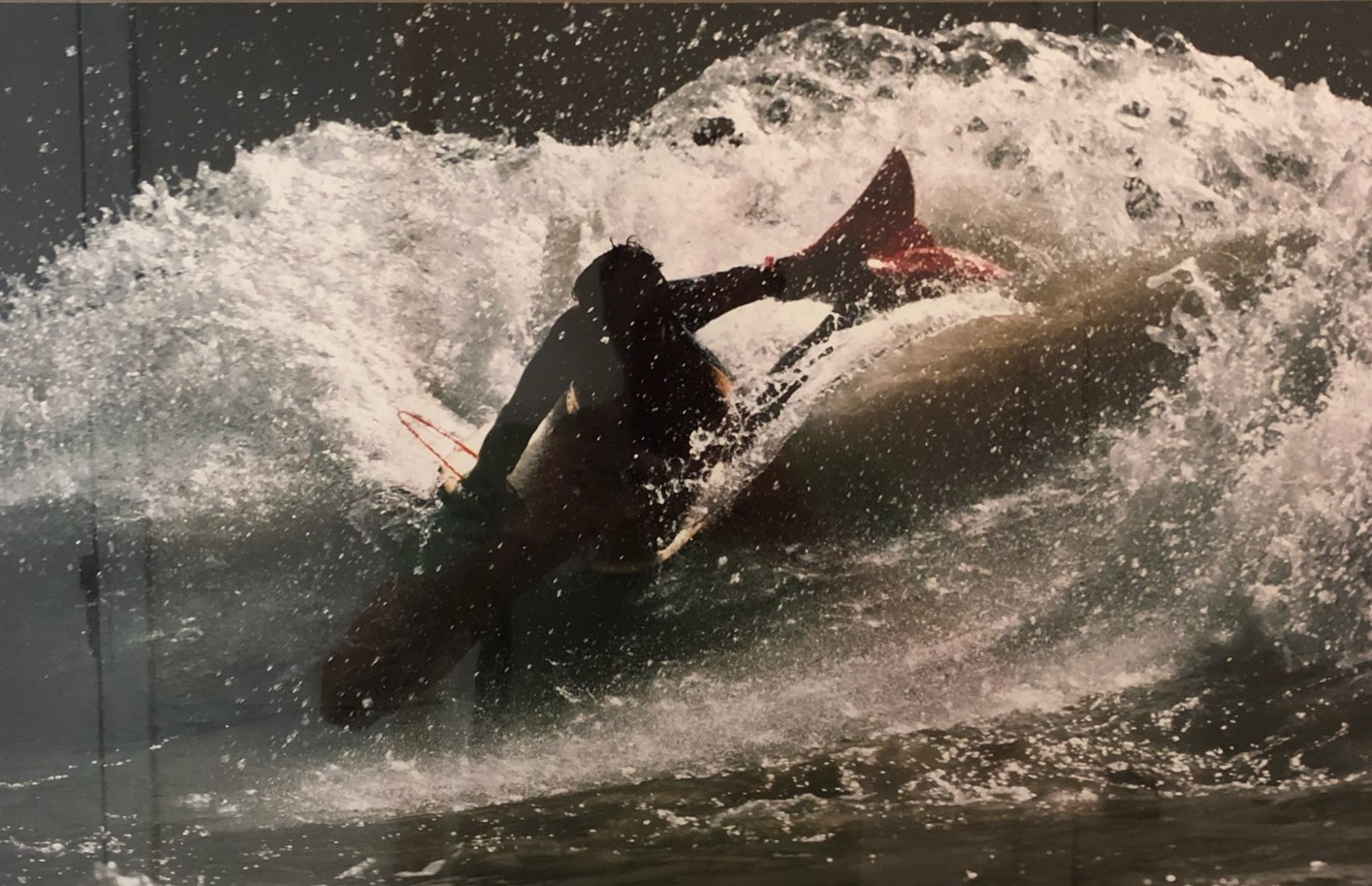
Robbie Meistrell “throwing tail” during the 1985 Body Glove International trip to Lunch Counter. (Photo: Robert Beck)
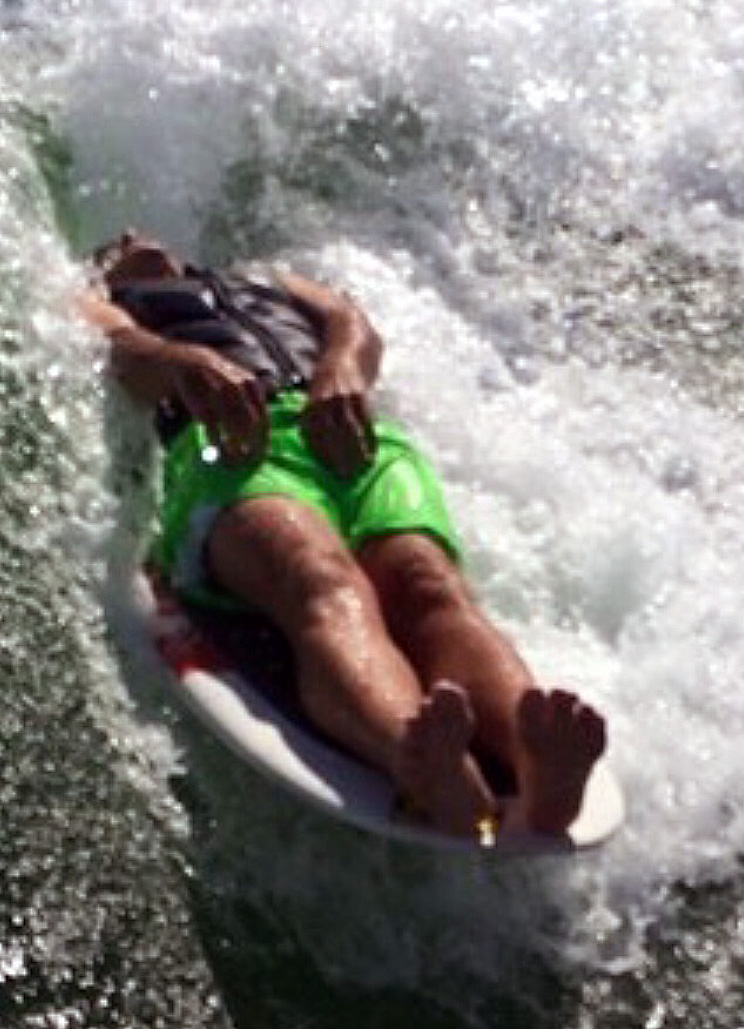
Billy Meistrell fully committed to a coffin in 2017. (Photo: Billy Meistrell)
John Scott is a 45-year resident skier and whitewater kayaker in Jackson Hole, Wyoming. He is a former whitewater river guide on the Snake River and professional ski patrolman on nearby Snow King mountain. John founded the Paddle Shop which was the first retail store in the Valley dedicated solely to river sports. After working the retail side, John then moved on to become Executive Vice-President and part owner of Life-Link International, an outdoor products manufacturer that created brands like Croakies® outdoor accessories, Life-Link backcountry ski products and Simms® fly fishing gear. John also founded the United States Ski Mountaineer Association (USSMA) dedicated to the sport of ski mountaineering. John and his wife of 35 years, JoAnne, raised three children in the mountains and he continues to ski and paddle in the Tetons.
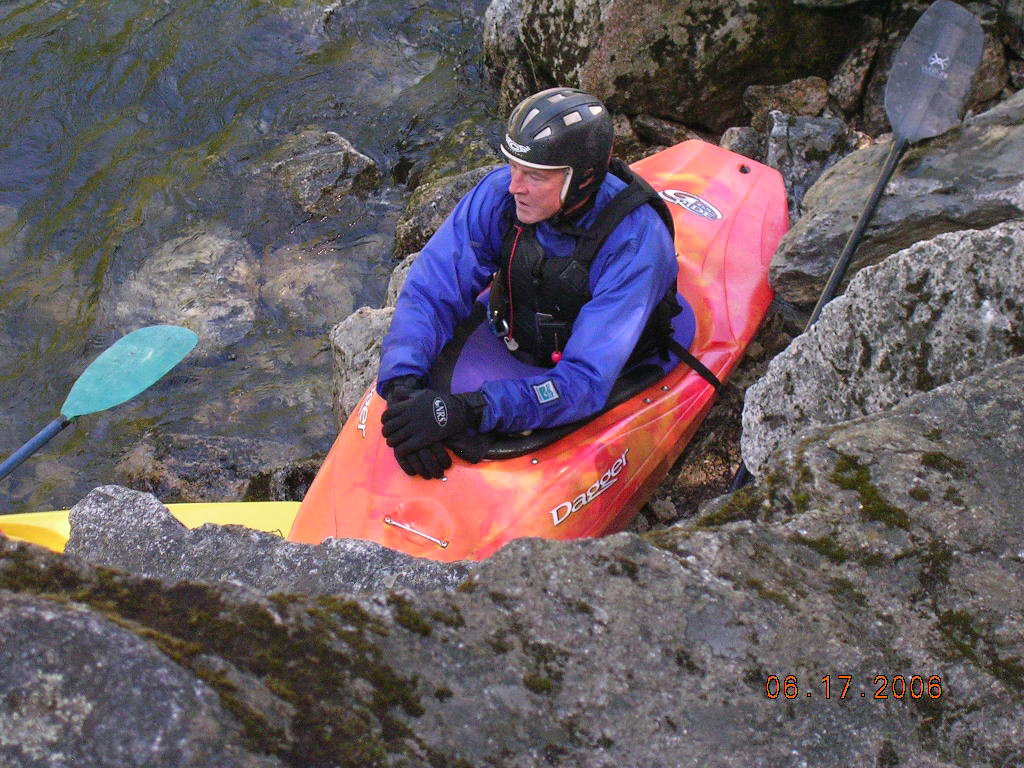
John Scott waiting for his turn on the wave at Lochsa in 2006. (Photo: John Scott)
Snake River, Wyoming in 1986
As a result of the Body Glove Lunch Counter promotions, Robbie Meistrell fielded inquiries from the multinational food, snack, and beverage cooperation PepsiCo about the feasibility of filming a river surfing commercial on the Snake River. Body Glove Team surfer Steve Machin already had an agent with LA Models, so he was ready with his portraits and portfolio when the casting call came. The Body Glove sponsorship and scoring the cover shot on the December 1985 issue of Surfer Magazine helped him to land the part, but his 1983/84 river surfing experience on the Lunch Counter certainly didn’t hurt.
Steve and two as yet unidentified actors were featured surfing the Lunch Counter wave in the 1986 Mountain Dew soft drink television advertisement. He recalls that acceding to the producer’s vision for what the youth of America would respond to was more than a little frustrating. They supposed that formulaically attractive youth, strategically placed people and props, and over-the-top dramatization by the river surfers would appeal to their young, hip, and active target-demographic. They wanted to convey a fun-loving festive atmosphere, and according to Steve, surfer wipeouts factored heavily into their thinking. The young blond woman laughing hardily at one of Steve’s watery pratfalls is the actor Katherine Kelly Lang. This was the year before she was cast in her long running role as Brooke Logan in the soap opera “The Bold and the Beautiful”.
Steve was hired to teach them how to river surf, and by his description it was no small task.
Steve noted that the other two surfers were athletes and professional stuntmen, not experienced river surfers. John Scott confirmed that the two of them were on retainer for the production, and that they were not at all river savvy. Steve was hired to teach them how to river surf, and by his description it was no small task. He spent a week before the production filmed coaching them to their feet. Part of that process involved having them lay prone and hold onto a rope while he steered them out onto the wave face. Their fitness and Steve’s skills as an instructor are born out in the clips of the actors surfing upright in the commercial, if not exactly ripping it. He recalls the producers even tried sending several young female actors into the river on boards, but without training it did not work out. Taking all the theatrics into account, the ad does showcase Steve Machin nailing an absolutely rock-solid backside snap.
1986 Mountain Dew Commercial at Lunch Counter featuring Steve Machin.
John Scott has contracted safety boating for a number of Hollywood movies and large-scale productions, including the 1986 Mountain Dew commercial. In bidding for such contracts, John explained that certain amenities are mandatory for the cast and crew. For example, all bids had to include “craft service.” Craft service workers are covered by a collective bargaining agreement and represented by a union. Craft work can involve camera, sound, electrician, and prop people. There are various art and set directors, hair and make-up specialists, and so on. Food is a craft service, and must be available at all times to the cast and crew members while they are working. All of the staff had to be ferried across the river, and there was a craft table set up on the far bank. Plates, silver, table covers, and other table wear were required, and the table was stocked with food, snacks, beverages, as well as various sundries like bandages, aspirin, and sunscreen.
Machin noted that besides the excellent compensation he received for his role, other amenities included accommodations and a generous cash peridium for the two weeks of production. There was safety boating backup and ready access to the craft table with all its bits and bobs. They even had heat lamps set up on the far bank to warm freezing surfers, which it turns out were absolutely essential. Eager to project the impression of warm summer fun, the surfers were cast in entirely too small and appallingly thin wetsuits given the icy water temperatures.
Mike FitzPatrick was hired as a river surfing consultant, safety kayaker, and rigger to help set up shots for the Mountain Dew commercial. Both Fitz and Machin referenced a raft hooked by a carabiner and sling to a taught cable strung clear across the Snake River. Its purpose was for alternative point-of-view camera angles, although none appear in the final cut of the commercial. Fitz noted that, “It was definitely something the National Forest Service would not have approved of.” The commercial’s upside was that its broad national release had an undeniable impact by repeatedly exposing tens of millions of American television viewers to the concept of board-surfing on a river wave.
One of Wyoming’s nicknames is the Cowboy State. The Mountain Dew commercial was filmed years after the peak of “country pop”, as exemplified in films like “Urban Cowboy” and Barbara Mandrel’s song, “I Was Country When Country Wasn’t Cool”. By the mid-1980s real country culture was returning to its traditionalist roots, but there was still room to milk the “Dew it Country Cool” theme, dress surfers up in cowboy boots, and pose an actor in a cowboy hat surfing on the Snake River.
Machin river surfed the Waimea River in an era well before it became widely popular and world famous.
Steve Machin moved to the island of O‘ahu in 1988. He parlayed his heavy water experience and water safety skills into a position life guarding at Waimea Bay on O‘ahu’s North Shore. Machin river surfed the Waimea River in an era well before it became widely popular and world famous. Waimea Bay was already famous for its massive waves that attract the best big wave surfers on the planet. The big wave spectacle and picturesque beach are also a magnet for hordes of tourists and other not very ocean conscious people. The combination spawns the most demanding lifeguarding on the planet. In time he was invited to join the Hawaiian Water Patrol, an elite collective of water-safety personnel specializing in extreme ocean safety and water patrols for the world’s foremost surf contests and movie productions. Machin worked water patrol in eight of the nine Eddie Aikau Big Wave Invitational Contests at Waimea Bay.
Steve Machin is currently the President/CEO of Machin Marketing which specializes in brand development, sales, and distribution of many front-line action sports brands, energy drinks, and select spirits. He is 53 years old, has been happily married to his wife Christina for 20 years, and has four children. He lives in La Pine, Oregon, not far from the powdery winter slopes of Mt. Bachelor and the river surfing wave in Bend, Oregon. His recreational pursuits of late include ocean surfing, river surfing, snowboarding, and stand up paddle boarding.
The idea of a perpetual wave that never stops breaking was a revelation to many ocean surfers, this author included.
The idea of a perpetual wave that never stops breaking was a revelation to many ocean surfers, this author included. I once read a fictional story about an infinite wave that wrapped completely around a fantasy island until it was literally surfing itself. Mid-1980 surf magazine features, photographs, wetsuit ads, and watching the lip of the Lunch Counter wave spill over and roll forward on its own slip face in a soda commercial hinted that fantasy wave could actually exist.
Snake River, Wyoming 1988 – 1991
From 1988 through 1991 Seal Morgan and I surfed the Lunch Counter every weekend that it was breaking, and as time allowed during the week. Because the Big Kahuna rapid would start to break just when the surfing wave on the Lunch Counter began to back off, we lingered there well into mid-summer. Research for this article suggests Seal and I were likely the first to board-surf the Big Kahuna beginning in 1988. Seal and my Lunch Counter river surfing experiences from 1987 through 1992 are well documented in the Lunch Counter Trilogy: Part 1, Part 2, and Part 3.

The Lunch Counter Trilogy: Part 1: In the Beginning; Part 2: Camping, Big Waves, & Bikinis; and Part 3: The World’s Eyes on River Surfing. (Photo: Riverbreak)
Our initial river surfing experiences were strictly trial-and-error. There were no other river surfers around to show us where to get in and out of the water, the safest places to ferry across, or how to react after the inevitable wipe-outs. I rented a dry-suit to keep me warm until I could drum up a wetsuit. We rode twin-fins and a squash-tailed channel bottom single fin that Seal shaped and glassed in his Ocean Beach, California fiberglassing/surf shop. We camped walking distance from the Lunch Counter wave, right where the parking lot is now located.
The camping and surfing that we experienced at Lunch Counter in those early years was magical.
We made do and over the years came to know that stretch of river in all water levels, weather conditions, and many moods. The camping and surfing that we experienced at Lunch Counter in those early years was magical. It was as though we’d discovered surfers’ paradise.
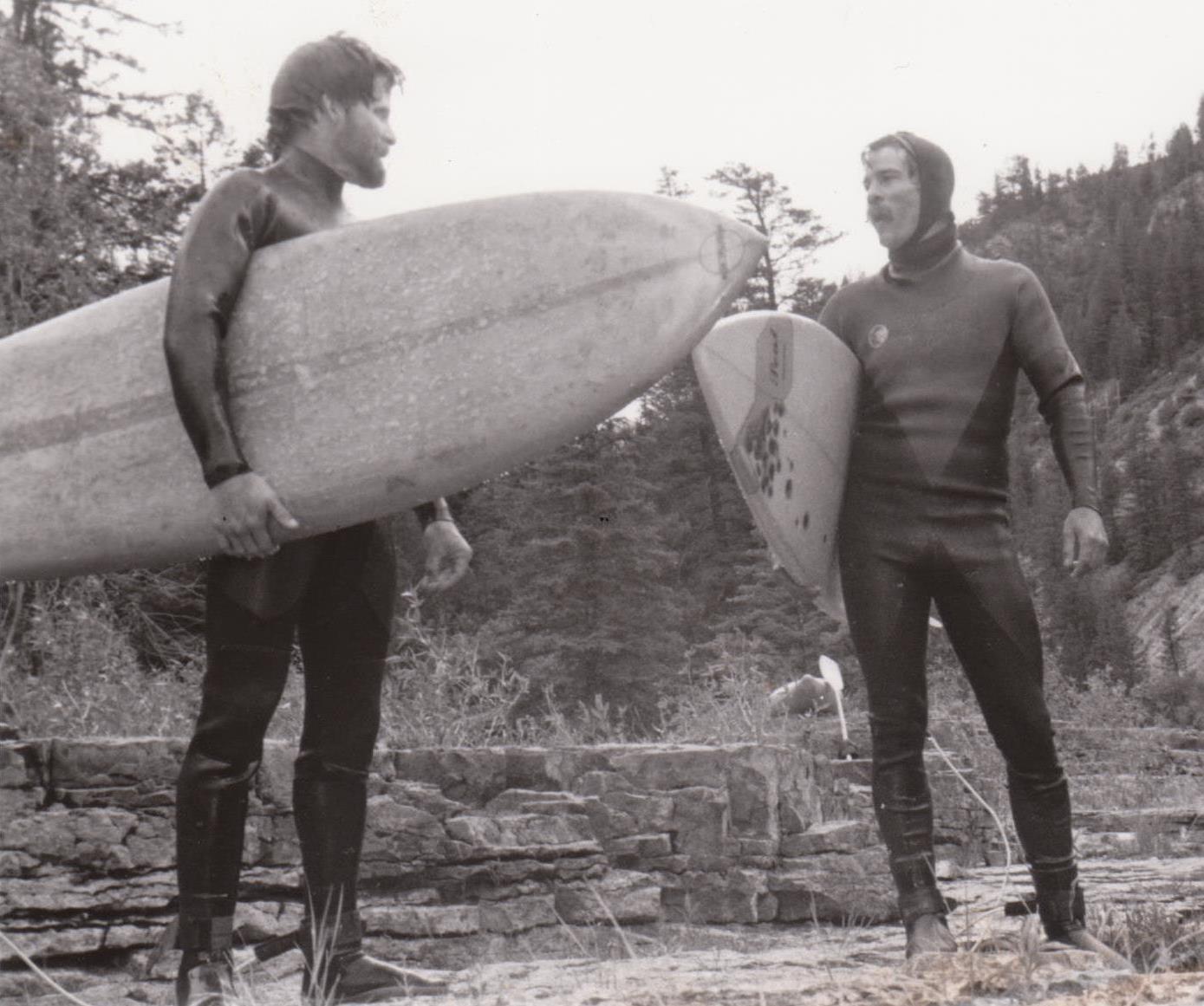
Don Piburn holding the Seal Team fish and Seal Morgan with the Seal Team twin-fin, 1990. (Photo: Seal Morgan)
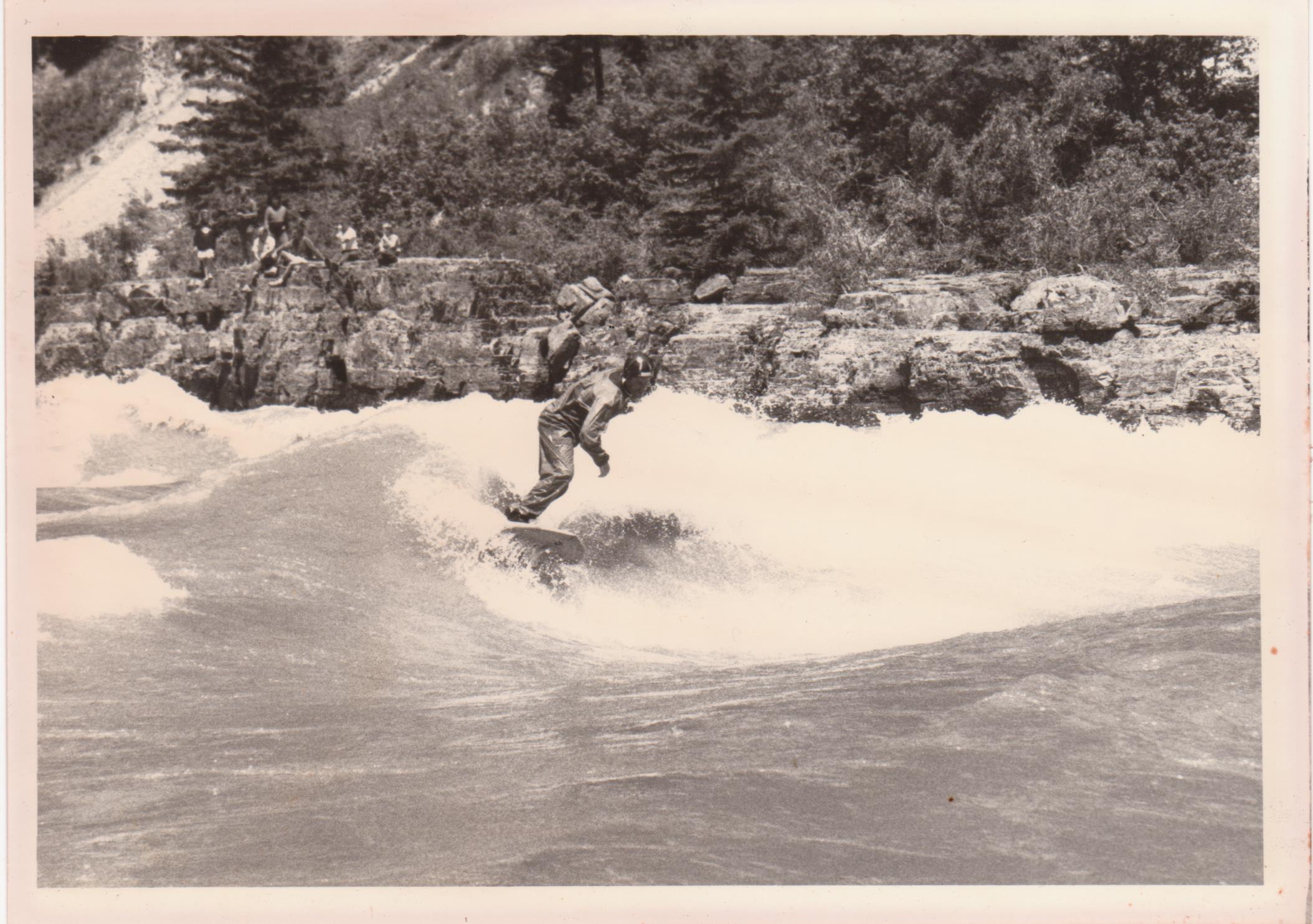
Don Piburn in dry suit and helmet surfing the Seal Team fish, 1988. (Photo: Don Piburn)
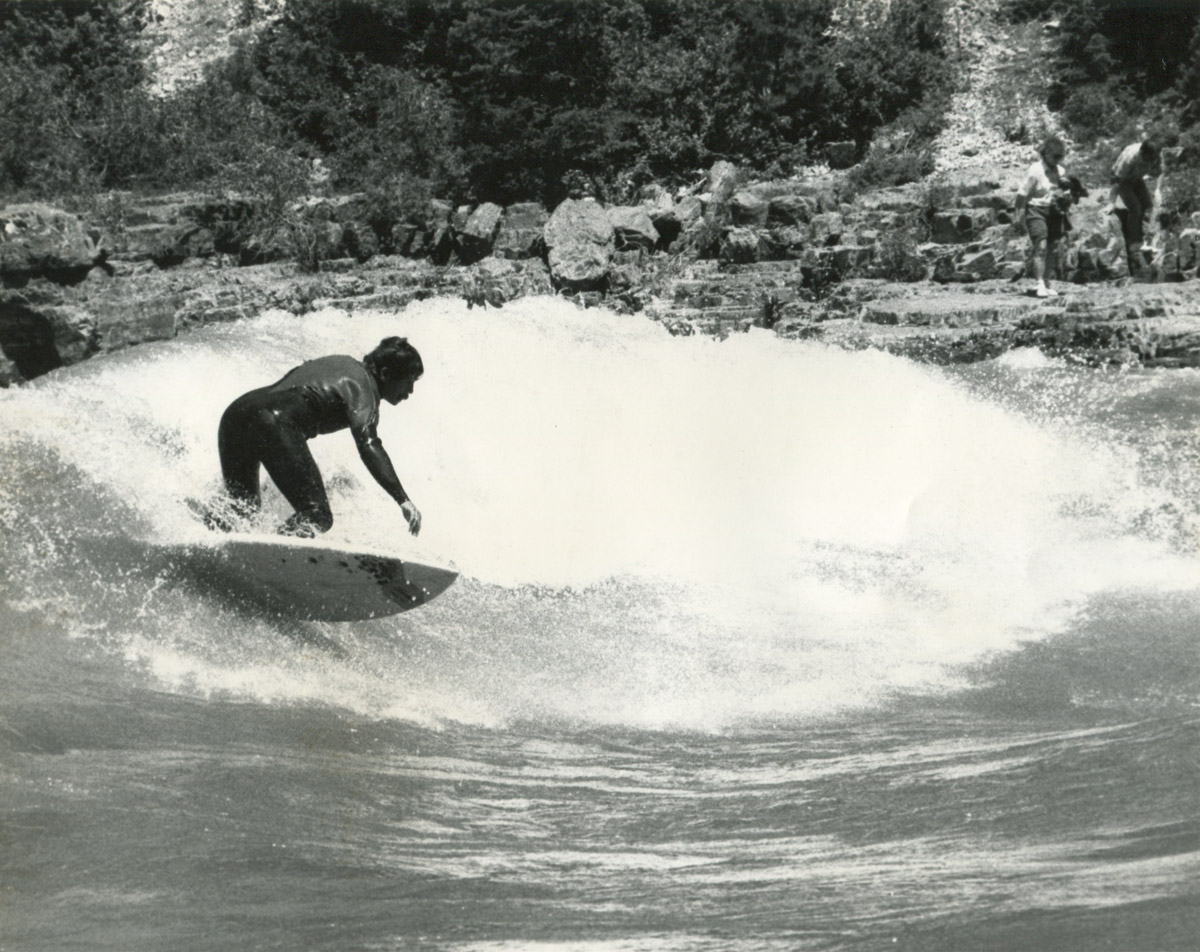
Seal in big water surfing the Seal Team twin-fin, 1989. (Photo: Seal Morgan)
We began sharing photos and video clips of our river surfing experiences with frontline contacts at major surf publications, but they were readily dismissed as “novelty.” A collection of river surfing articles featuring the two of us were published in regional sports magazines between 1989 and 1992. This included a 1989 feature on Seal entitled “Surf’s up on the Snake” published on the front-page of the Jackson Hole News. The number of surfers riding Lunch Counter swelled from all the regional exposure, sowing what was possibly the first North American community of river surfers. When Seal moved away in 1991, he left his favorite magic twin-fin behind for me to use, and I was able to squeeze in one more eventful river surfing season in 1992.
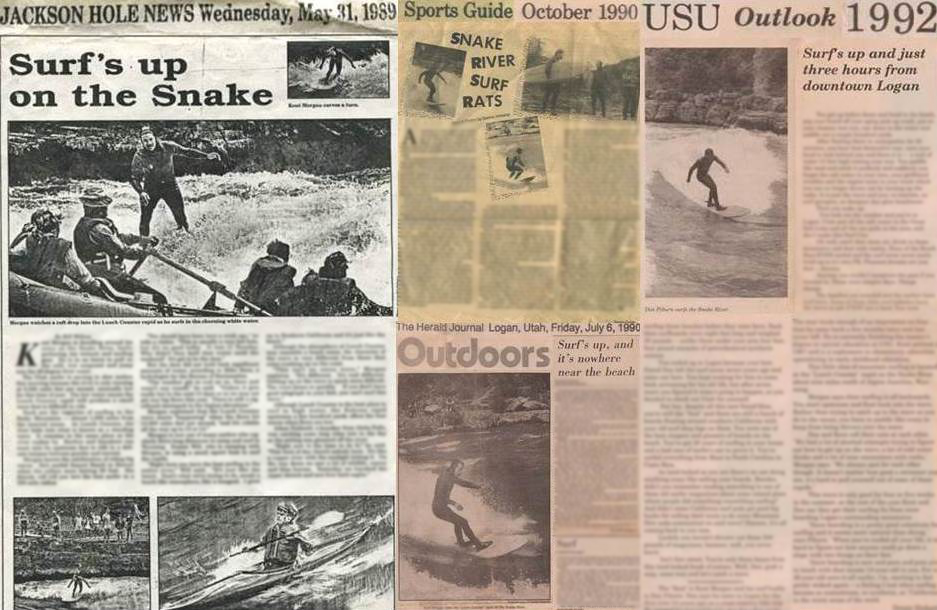
Montage of Regional Articles featuring Seal Morgan and Don Piburn river surfing Lunch Counter 1988 – 1992. (Photo: Don Piburn)
In October of 2017 Seal attended, river surfed, and wrote about the First North America River surfing Summit held in Bend, Oregon. He was there as a freelance writer for OutThere Outdoors Magazine in Spokane, Washington. The magazine was trying to generate interest in funding for a similar wave structure in the very sizable Spokane River. Another version of these articles was published in a small publication in Ocean Beach California (now at www.obrag.org), the same SoCal beach town Seal was born in. The Summit was the first time he had river surfed since 1991. He was welcomed by the local Bend surfers and given a whirlwind tour of Bend’s nightlife over the 3 days/2 nights he spent with them. Great fun!
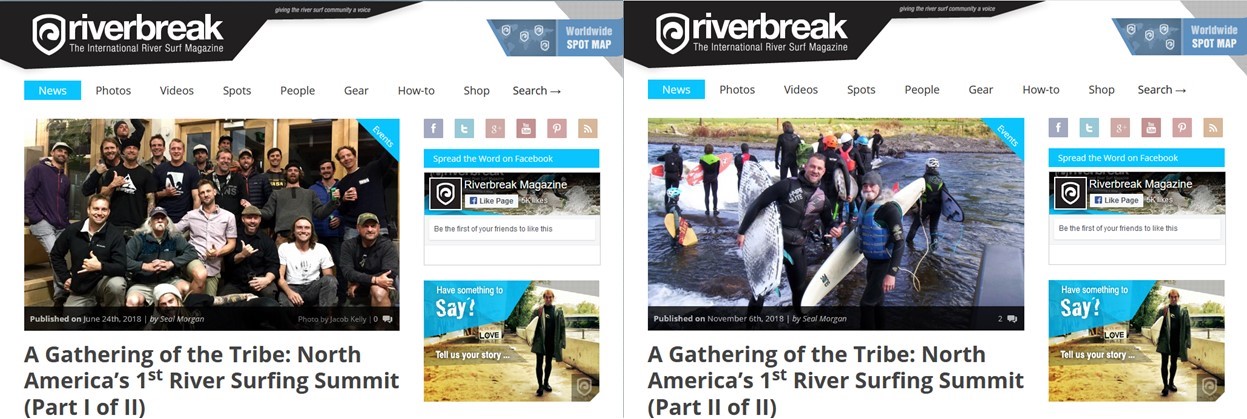
A Gathering of the Tribe: North America’s 1st River Surfing Summit (Part I of II); A Gathering of the Tribe: North America’s 1st River Surfing Summit (Part II of II). (Photo: Riverbreak)
Seal Morgan is now in his mid-60s and teaches free snowboard lessons at 49′North, Kenpo in his home dojo, wake-surfs old Hyperlites, and regularly uses 1970s pool rider skateboards when he goes to town. He lives in the Selkirk Range of NE Washington State where he builds custom winter gear for locals in his sew shop www.boardwarm.com.
Snake River, Wyoming 1992 – 1994
In 1993 I submitted one of my 1992 Lunch Counter video clips to ABC Television’s America’s Funniest Home Videos (AFV). They noted no immediate need for it, but said they would hold onto my footage in their archives. Years later, in 1998, I was contacted by representatives of Disney-ABC Television Group telling me that my clip had been selected as a $10,000 semi-finalist for an upcoming AFV episode. Copyrights prevent them from showing my appearance on the show here, but you can watch a copy of my clip graciously provided by the Vin Di Bona Productions/Cara Communications Corporation affiliated with AFV.
AFV arranged to fly me from my then home in Hawai‘i to Los Angeles, where I was chauffeured around Hollywood in a limousine, put up in a nice hotel, and featured in a closeup on the show with my Lunch Counter river surfing clip. All expenses were paid, including a small peridium. I did not win the $10,000 first prize. My video never really was funny, plus I was competing against puppies, babies, and genuinely hilarious little kids. I came in second place though, which netted me two-grand in prize money. That’s not a bad take in 1998 dollars, to go along with a pretty good story. In the era before widespread internet use, each 1998 AFV episode carried close to 8 million households. Thus, many tens of millions of people saw my clip, and that’s without factoring in global syndication, reruns, and the fact it ran twice on the show. River surfing gained significant international exposure.
Don Piburn’s America’s Funniest Home Videos (AFV). Clip “Surf’s Up: River”. The clip was from 1992, and episode aired on April 27, 1998. Courtesy of Vin Di Bona Productions/Cara Communications Corporation.
I met Mike Morganson and Tony Jovanovic surfing the Lunch Counter during the 1992 river surfing season. Mike and Tony attended the same high school in Huntington Beach California in the early 1980s, before they both moved to Jackson Hole to ski and snowboard. They surfed regularly at Lunch Counter from 1992 through 1994. They were among a short list of highly accomplished river surfers the last year I surfed there in 1992.
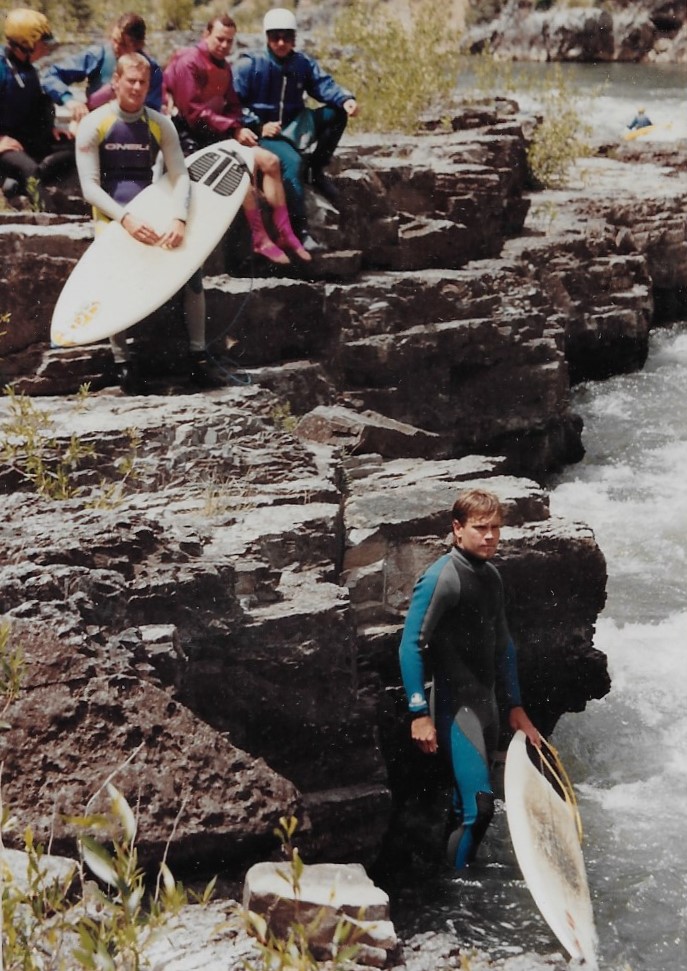
Mike Morganson and Tony Jovanovic at Lunch Counter in 1992. (Photo: Don Piburn)
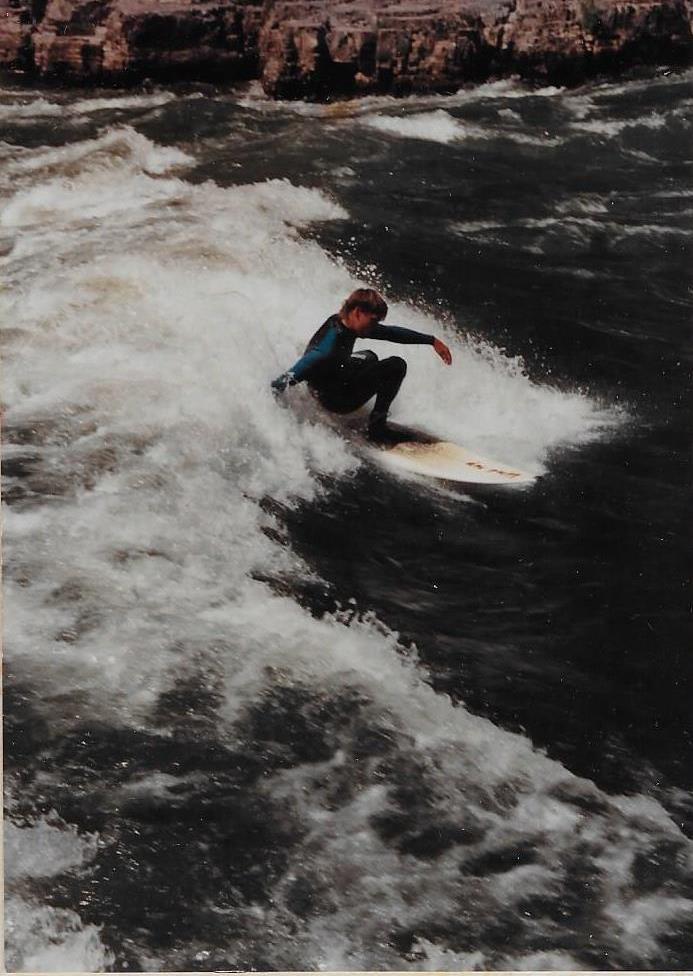
Tony Jovanovic at Lunch Counter in 1992. (Photo: Don Piburn)
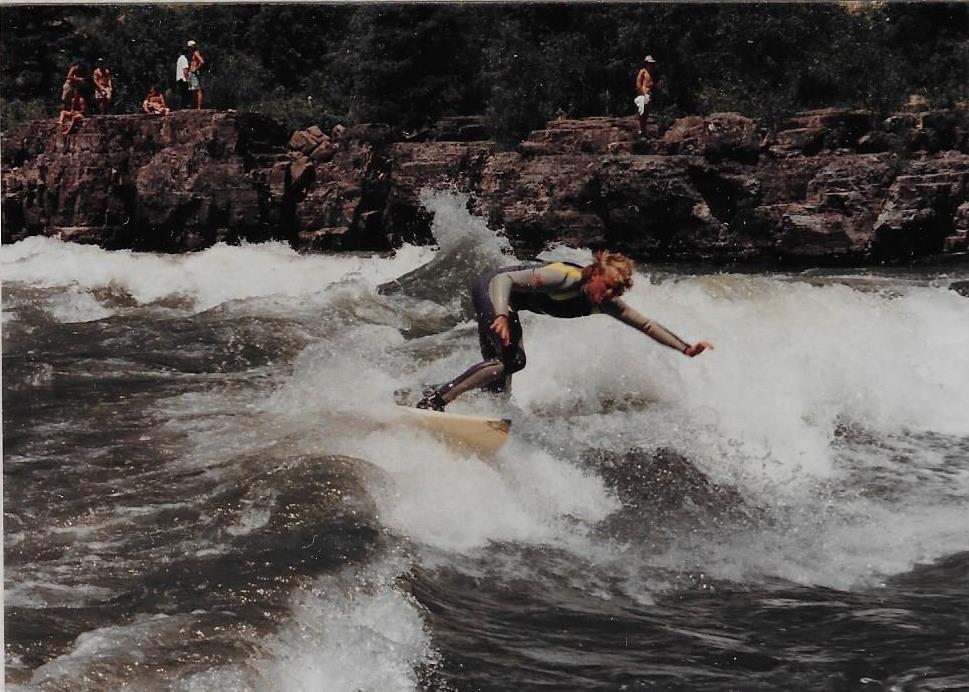
Mike Morganson at Lunch Counter in 1992. (Photo: Don Piburn)
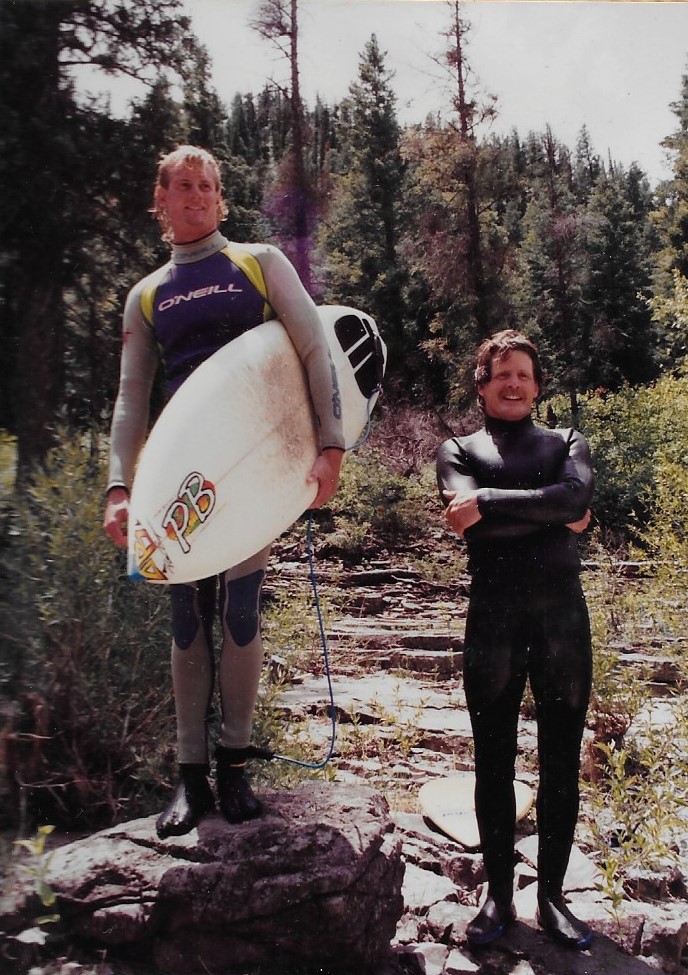
Mike Morganson and Don Piburn at Lunch Counter in 1992. (Photo: Don Piburn)
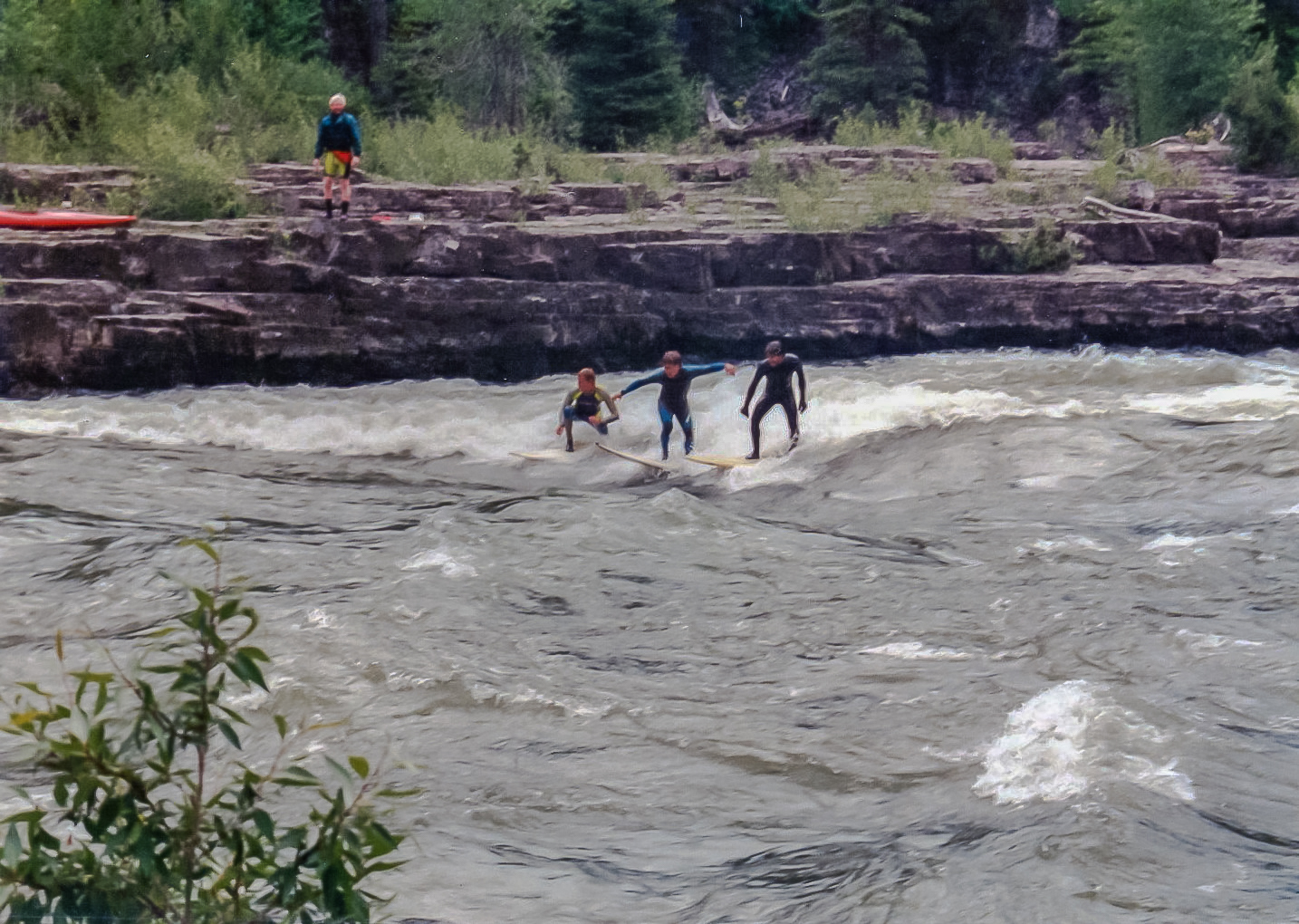
Mike Morganson, Tony Jovanovic, and Don Piburn sharing Lunch Counter in 1992. (Photo: Tony Jovanovic)
The three of us were among a handful of Lunch Counter locals invited to audition for a Toyota Trucks commercial filmed at Lunch Counter in 1992. Mike and Tony were selected to star in the commercial, and they invited me to be there on the day it was filmed as their guest.
In addition to the millions so exposed, its broadcast reach included airing during the 1993 World Series of Baseball, which alone ran internationally to over 20 million viewers! River surfing gained sprawling international exposure.
Pictures and stories from that day can be found in Lunch Counter Trilogy 3, appropriately named, “The World’s Eyes on River surfing”. Their commercial was broadly released on national television the following year. In addition to the millions so exposed, its broadcast reach included airing during the 1993 World Series of Baseball, which alone ran internationally to over 20 million viewers! River surfing gained sprawling international exposure. Mike and Tony parleyed their earnings from the commercial into a surf trip to Costa Rica.
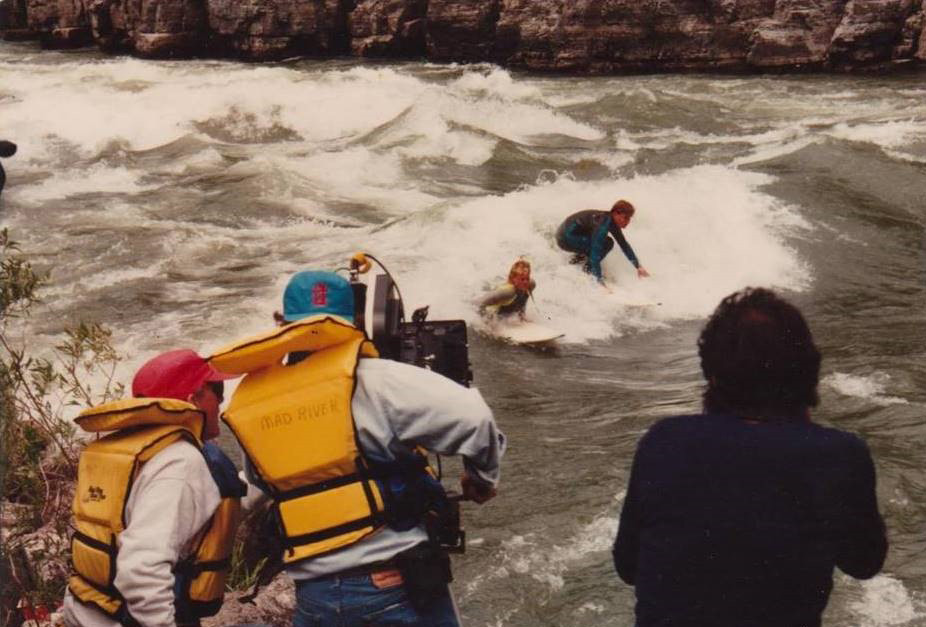
Tony and Mike during the 1992 filming of the 1993 Toyota Trucks commercial. Image and story from The World’s Eyes-on River Surfing. (Photo: Don Piburn)
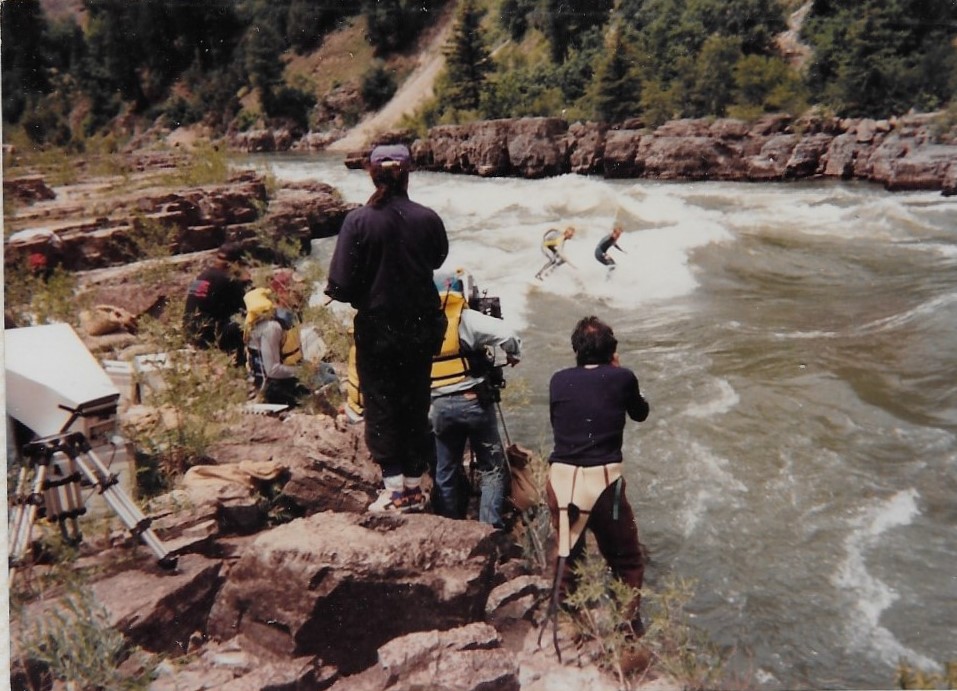
Tony, Mike, and production crew during the 1992 filming of the 1993 Toyota Trucks commercial. (Photo: Don Piburn)
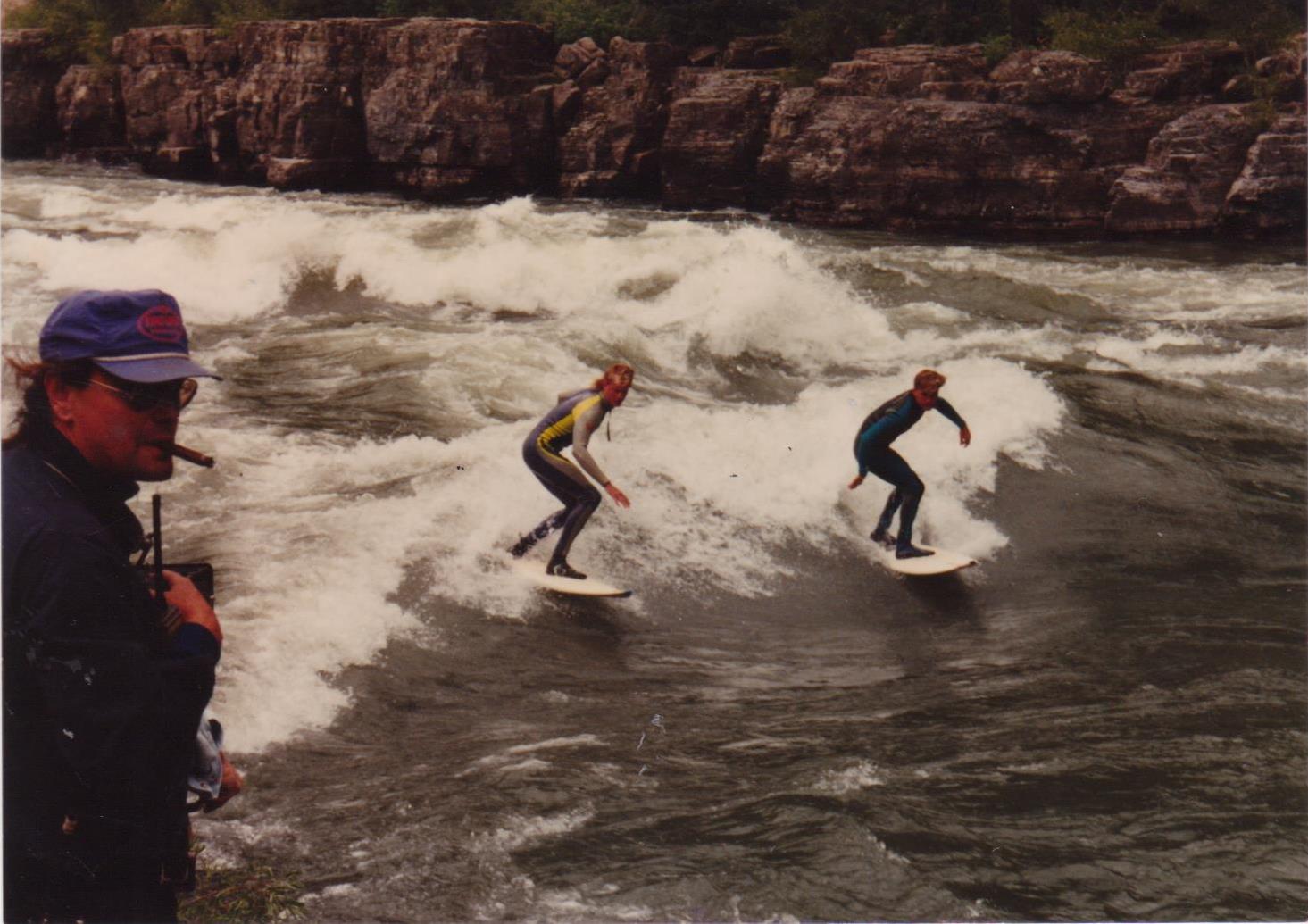
Tony river right, Mike in the middle, and the Director at river left filming the 1993 Toyota Trucks commercial. (Photo: Don Piburn)
In 1993 Tony and Mike were featured on cable TV surfing Lunch Counter by a sports media outlet called Scratch TV. In addition to their first-hand accounts of what it was like to surf the Snake River in 1993, the report includes a brief clip of their 1992 Toyota Trucks commercial at the Lunch Counter. Tony has also posted a clip of Scratch TV’s raw footage, which contains unedited clips of Tony and Mike surfing the Lunch Counter and Juice Box waves. It has always been standard practice to catch and surf the Juice Box for as long as its pulsing nature allowed, especially when a surfer was paddling river right to get back to the roadside bank.
Scratch TV Raw Footage. Includes clip of 1993 Toyota Trucks commercial.
Tony was likely the first to board-surf King’s Wave in 1993, a stationary wave located several miles upriver of the Lunch Counter on the Snake River. King’s Wave can be accessed or viewed via a simple trail off a solitary highway pullout exactly one mile downriver from the Hobach Junction. It has always been a very popular wave with the kayakers as a place to practice their free-style skills. Tony describes the wave as further out into the river, thus backing in from upriver is the only way to catch it. Although catching it can be a challenge, kickouts are fairly benign. There was nothing particularly scary immediately downriver, thus it was a quick punch through whatever river right eddy that was accessible.

Tony Jovanovic was likely the first to board surf King’s Wave on the Snake River in 1993. (Photo: Tony Jovanovic)
Lochsa River 1993 to 1996
Another accomplishment for Tony includes likely being the first to board-surf the Lochsa Pipeline in 1993, a river break located on the Lochsa River near Lowell, Idaho. Tony had heard about the wave’s surfing potential from a local kayaker, so he set out on a road trip to look for it. He stayed with a friend in Missoula, Montana and searched upriver until he located it. He notes that you enter the wave from its left side (river right), and that exiting the wave means sprinting for the nearest eddy line. If you are slow or unlucky and miss it, the currents will flush you well downriver. Tony added that a fun feature of the wave is that you can traverse to river left and surf that shoulder, but you have to time this with the surges of the water. Sometimes the wave goes flat and then it picks up and throws a small tube, thus the name “Pipeline”. Tony returned multiple times, and he and Mike surfed it together in 1996 as documented in Tony’s pictures posted here.
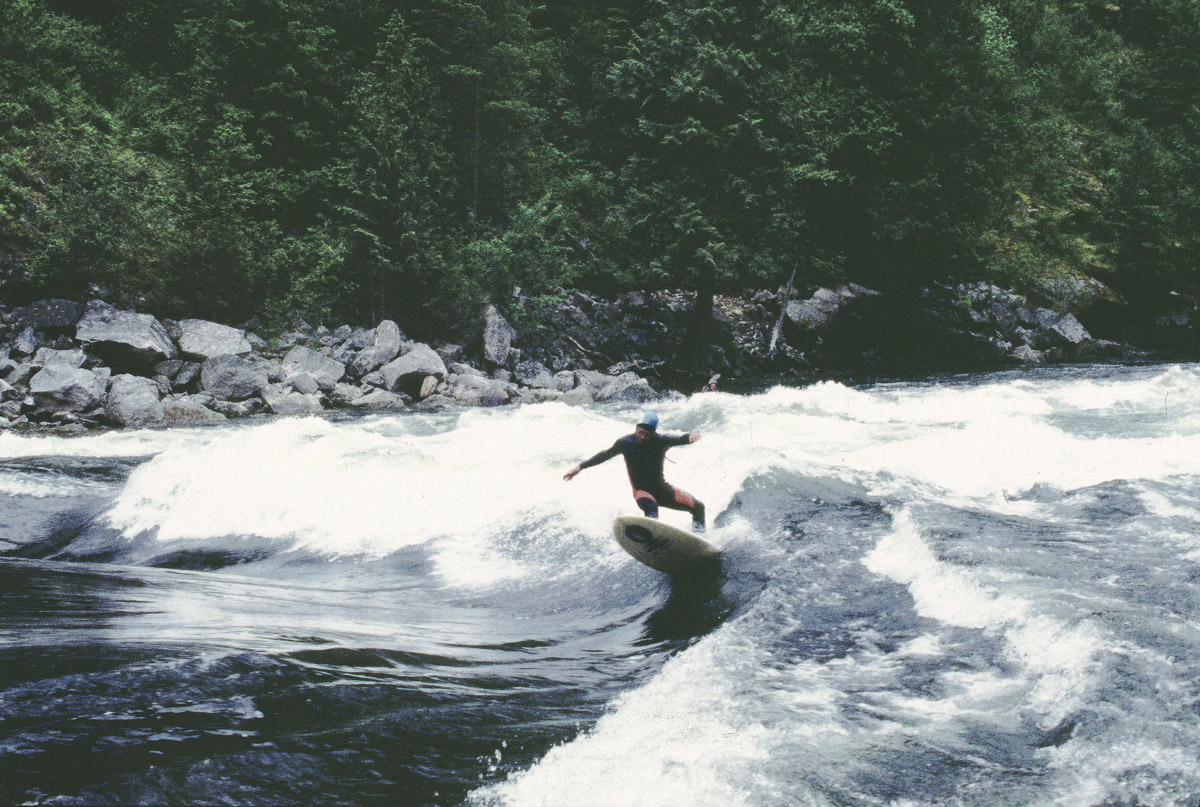
Tony Jovanovic Lochsa Pipeline in 1996. (Photo: Tony Jovanovic)
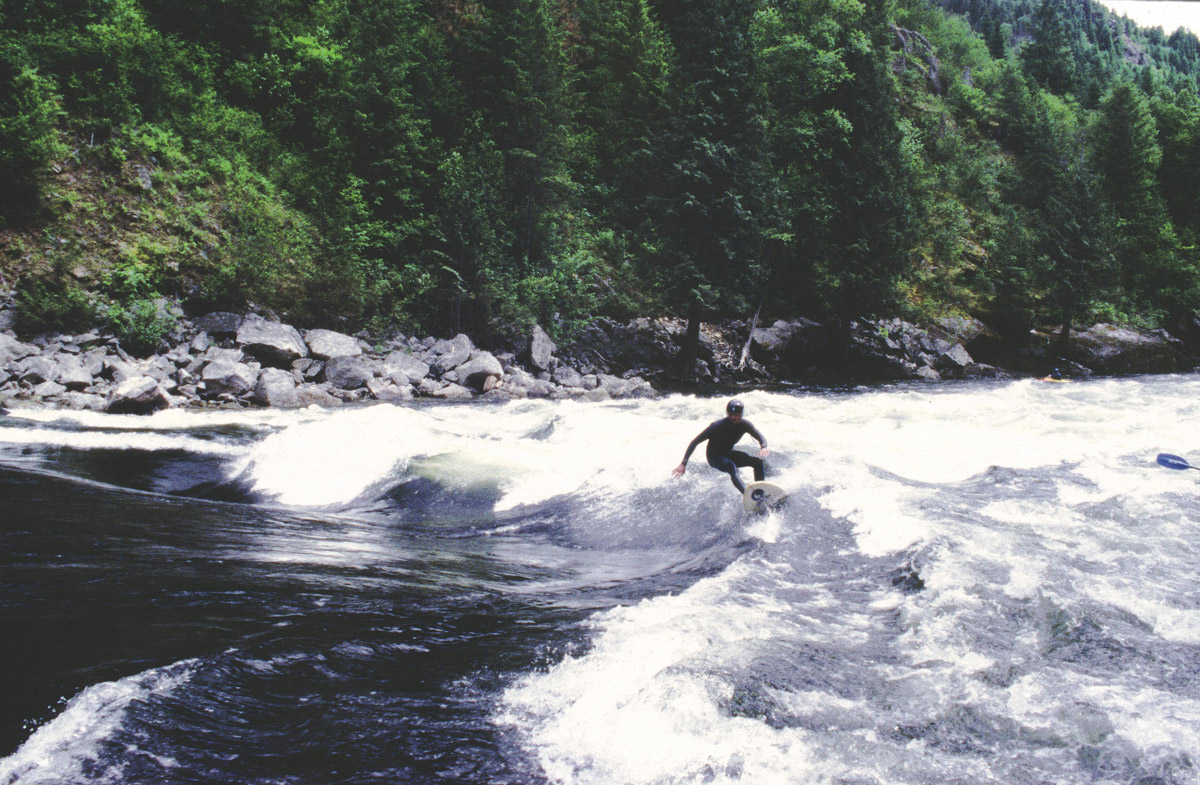
Mike Morganson surfing Lochsa Pipeline in 1996. (Photo: Tony Jovanovic)
Mike Morganson now lives not far from the many quality beach and reef breaks of North County in San Diego, California. Mike says that he doesn’t surf as often as he once did, finding the crowds of suburban surfing a little dispiriting. He is married with a son, and their family both supports and participates in youth sports.
Columbia River 1994 to 2000
Tony moved to Rossland, a small city in the West Kootenay mountainous region of British Columbia (BC), Canada in 1994. He first river surfed nearby Lower Rock Island on the Columbia River in 1995, and later was likely the first to board surf the Upper Rock Island wave in 2000. He describes both waves as “fickle”, but rideable in the heat of the summer. The Columbia is big water, and Tony explained that it is not a place to try to fight the currents. You use them to carry you out of the main flow to the safety of a near shore eddy. The experience served to prepare Tony for the even bigger waters he would later river surf.
Tony was featured river surfing Lower Rock Island in the local newspaper, the Trail BC Daily, on Tuesday, October 5, 1995. He took his river surfing experience a step farther by submitting a proposal to the City of Trail, BC for the building of a manmade river wave feature in Gyro Park. The City Director of Recreation was interested, but the project never got traction. A separate project of Tony’s included engineering a scaled down fiberglass feature that could be placed in a suitable waterway to create a mini-wave. He based his design on the bottom contours he had seen at the Lochsa Pipeline during a 1993 visit there at particularly low water levels.
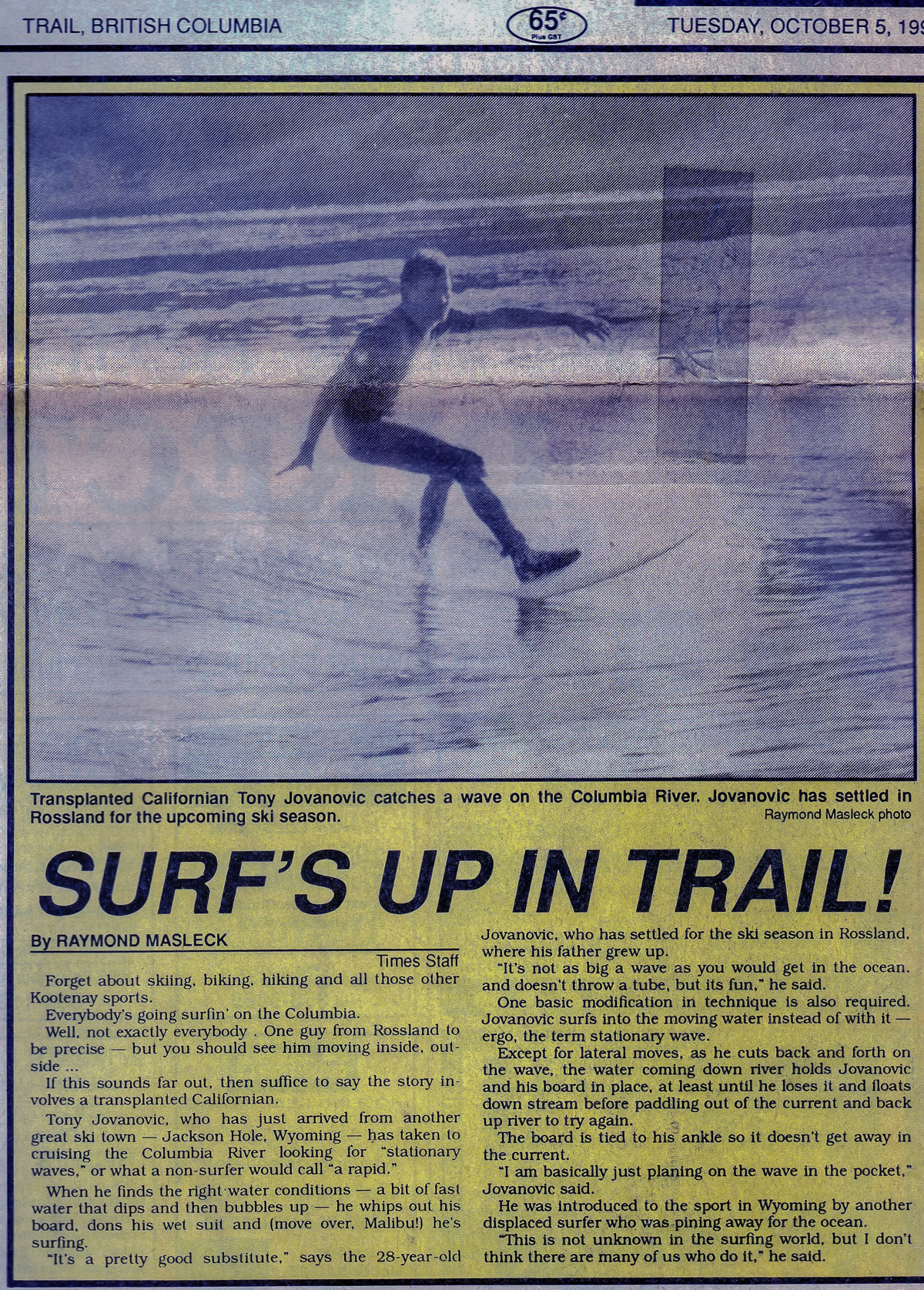
News clip of Tony Jovanovic river surfing Lower Rock Island on the Columbia River in the Trail BC Daily, Tuesday, October 5, 1995. (Photo: reproduced with kind permission of Black Press / Trail Times)
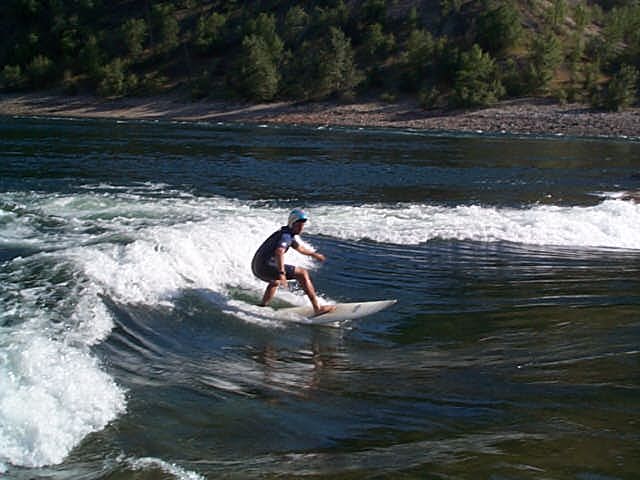
Tony Jovanovic river surfing Lower Rock Island on the Columbia River in 1995. (Photo: Tony Jovanovic)
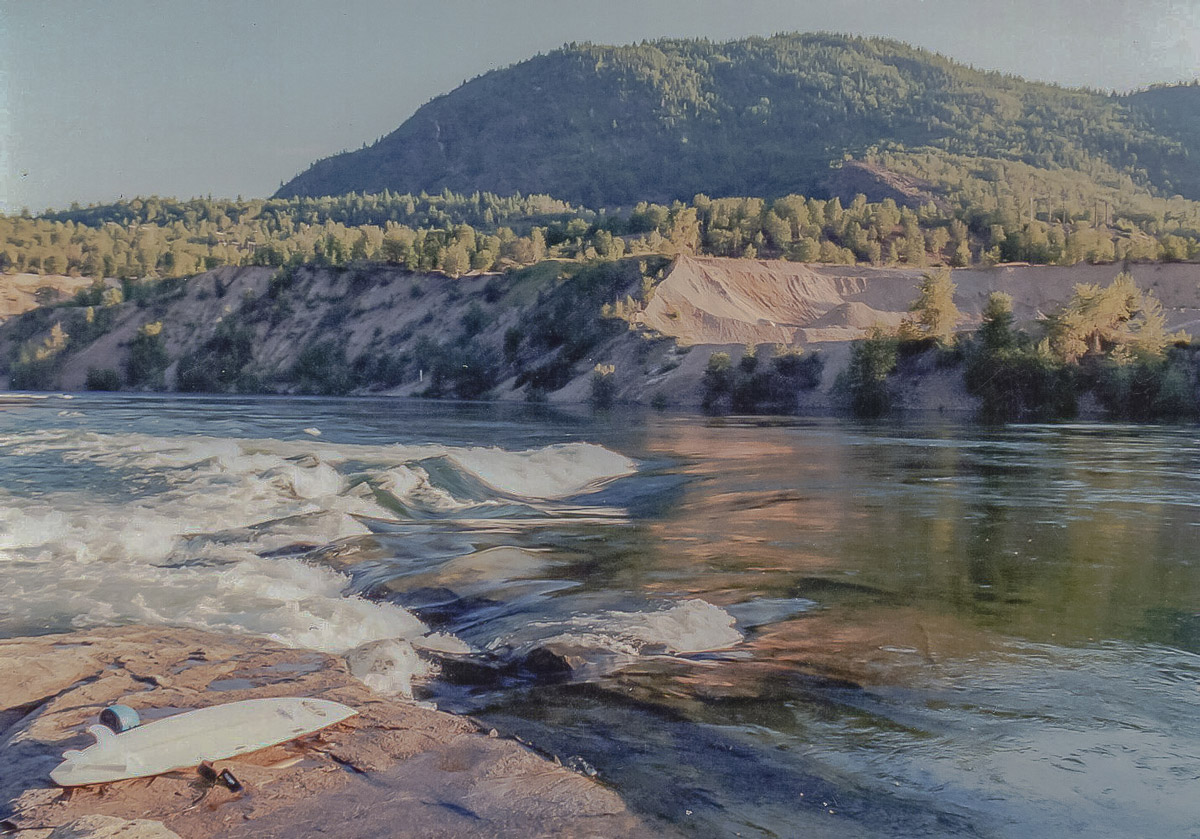
Tony all alone at Upper Rock Island on the Columbia River in 2000. This was before GoPro cameras, and there was nobody around to take his picture while he was up and riding. (Photo: Tony Jovanovic)
Tony related how he surfed King’s Wave, Lochsa Pipeline, and Rock Island all by himself. River surfers were few and far between back in those days. He reasoned that since he had gone to that much effort to get to such places, he would just commit and send it. His audacity proved useful.
Skookumchuck Narrows, BC 1999 to 2000
Tony Jovanovic is a native Canadian who originally hails from Creston, BC. It is only natural that a Canadian was the first to board-surf the ocean tidal rapid named Skookumchuck in July of 1999. It is located in the Skookumchuck Narrows section on Sechelt Inlet, a fjord in BC’s Sunshine Coast. Tony frequented the wave in both 1999 and 2000. The newspaper clip shown here is from the August 2000 issue of Coast Magazine, a British Colombia sports magazine. The underlined portions confirm Jovanovic was likely the very first to board-surf Skookumchuck in July of 1999. The underlined portions state, “In July of 1999 the newest wave-riding performance made his debut. But Tony Jovanovic of Rossland, B.C., did it standing up. With his trusty surfboard underfoot, he managed to claim the honour of board surfing the wave for the first time.”
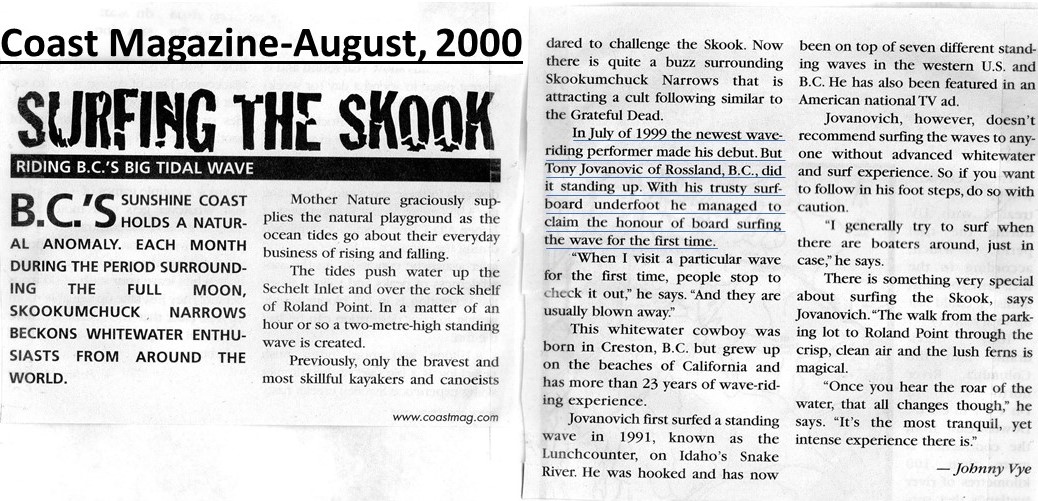
Coast Magazine, August 2000. British Colombia sports magazine. The underlined portions confirm Tony Jovanovic was very likely the first to board-surf Skookumchuck in July 1999. (Photo: Tony Jovanovic)
In describing this picture of his first session at Skookumchuck in 1999, Tony points out that this was before Personal Water Craft (PWC) or jet boats were used to tow surfers into the largest waves or as safety back-up. He says, “This is a picture of my very first visit to the Skookumchuck Narrows. It was big water, and the wave was breaking a solid 6 feet high by 25 feet wide. There were several kayakers present, but I still had to put in slightly upstream and back into the wave in order to catch it. I just went for it, hoped for the best, and it worked out.”
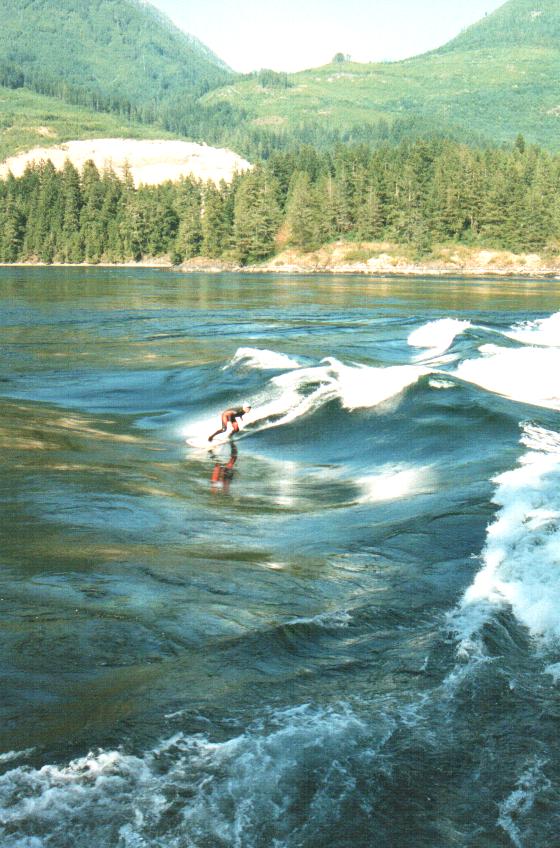
Tony Jovanovic during the first ever board surfing session at Skookumchuck Narrows in 1999. (Photo: Tony Jovanovic)

Tony Jovanovic sharing a wave face with playboaters on Skookumchuck in 2000. (Photo: Tony Jovanovic)
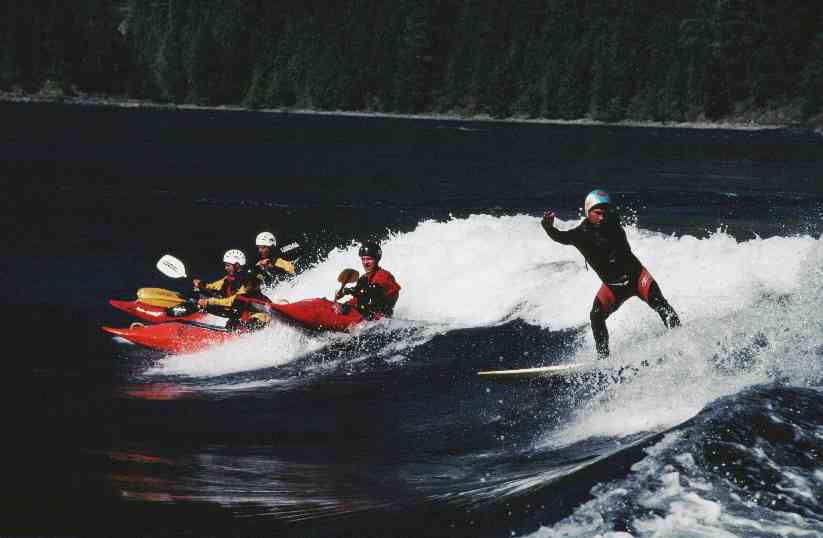
Tony Jovanovic sharing a cutback with playboaters on Skookumchuck in 2000. (Photo: Tony Jovanovic)
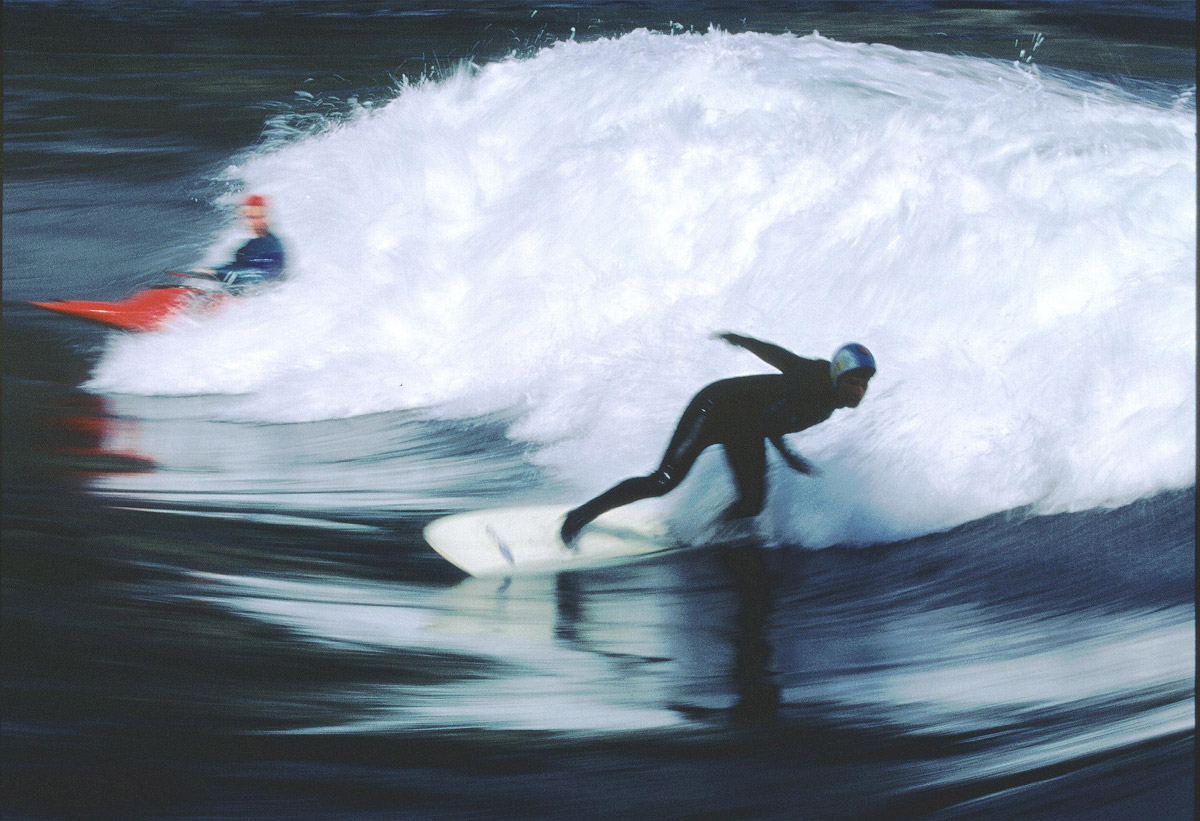
Tony Jovanovic bottom turn at Skookumchuck in 2000. (Photo: Tony Jovanovic)
In 2000 Tony was featured river surfing Skookumchuck by an extreme-sports cable show called Adrenalin TV. There were over a dozen kayakers queued up for the wave on the day of the shoot. One young woman is shown attempting to catch the wave on her body board. Tony is the only board surfer in sight. His observations, paired with his river surfing abilities, are featured prominently throughout the production.
Adrenaline TV – Tony Jovanovic surfing Skookumchuck in 2000
Tony had his heaviest river surfing experience at Skookumchuck on the very last day he surfed there. Here’s the story in his own words:
“Skookumchuck Narrows is by far the largest and most dangerous river wave I have ever surfed. I went there with a girlfriend. We arrived late in the day, and I was not planning on surfing at all. We made the hike to Roland’s Point, where the wave is located, simply to check it out. The tide was just starting to push up the Narrows.
Low and behold, I ran into several pro-kayakers I had met there previously, and they persuaded me to give it a go. I ran back and forth between my truck and the point mustering all of my gear. When I finally had everything by the shore, it was almost an hour later and the wave was going full bore. Usually I had a pre-game routine of stretching and visualization, but I had to forgo all that and just go for it.
The water was probably the strongest I have ever been in. After surfing a wave, I missed the exit eddy and was forced to take the whitewater tour. Fortunately, my friend the kayaker came after me. I grabbed the rope loop tied to the back of his boat. At one point while we were getting flushed, he called out, “You’d better hold on tight. We have a whirlpool developing in front of us!”
That was by far the heaviest situation I have ever been in, and it left me pretty spooked. It sounds incredible, but it’s a true story (Tony Jovanovic).
In a matter of seconds, we went from being horizontal on the water surface to getting corkscrewed vertically and being pulled down. I held on for dear life as the vortex spun us. At one point, all I could see was a small hole of light looking upwards as we were being drawn down. I suspect I was nearly ten feet below the surface, but still in a vortex of air. I never had to inhale water. His boat was also vertical, and he was paddling like mad to get us up and out of there. I was fully extended laying on my surfboard. The power was so strong that my right shoulder started to tear, and at that point I just had to let go. I came off my board and was being spun and bounced off my friend’s boat. Luckily, the vortex dissipated and released us up and out onto the surface. I was thrown out of the whirlpool on the main-flow side, and he exited on the shore side. He quickly returned and once we were reconnected, he pulled me into the shore side eddy. The sun was going down, and my girlfriend and the other kayakers had no idea what had become of us. It took him another half hour to paddle back to Roland’s Point along the shoreside bank. That was by far the heaviest situation I have ever been in, and it left me pretty spooked. It sounds incredible, but it’s a true story.”
Tony Jovanovic continues to live and work in the town of Squamish, along the south coast of BC. He was so taken by Costa Rica and its waves, that he and his wife now reside there for half of the year. He shared that he picked up a couple of new surfboards this year, with his 6’ 4’ double channel swallow tailed twin fin now his magic go-to board. He has applied a lifelong interest in photography to capturing the natural beauty, wildlife, and waves of his adopted home. Surfing water photography has become a particular passion, and his photos have been featured in a number of regional magazines. You can view Tony’s photography on his website at www.viadeagua.com.

Tony Jovanovic making a late drop at Puerto Sandino, Nicaragua in 2016. (Photo: Tony Jovanovic)
Conclusion
The attention span of the general public is notoriously short, and what was once celebrated is hastily forgotten. Firsthand accounts from North America’s earliest river surfers are few, and the chemical shelf life of their film and video technologies have long since lapsed. Many individuals who lived it are no longer with us to share their stories. It is increasingly important that authenticated stories, photographs, films, and video clips are ferreted out, preserved, and shared. Some accounts will undoubtably arise that extend or even supplant the many truths written here. That is precisely the point: To uncover as many dormant narratives from the eldest devotees of our sport as possible. River surfers in the late 20th century made extraordinary contributions worthy of recognition, respect, and preservation before time takes an even greater toll on what little is left.
About the Author
Don Piburn is a surfer, ’70s outlaw skateboarder, ’80s backcountry snowboarder, and a late ’80s Snake River surfer. He moved to Oah’u in the early ’90s where he completed a 35-year career teaching infants, toddlers, and preschoolers with disabilities. Recently retired, he now surfs ocean and lately Waimea River waves. He surfs and fishes from his kayaks on windward reefs, and regularly hikes with his Hawai‘i born and raised wife, Janice.
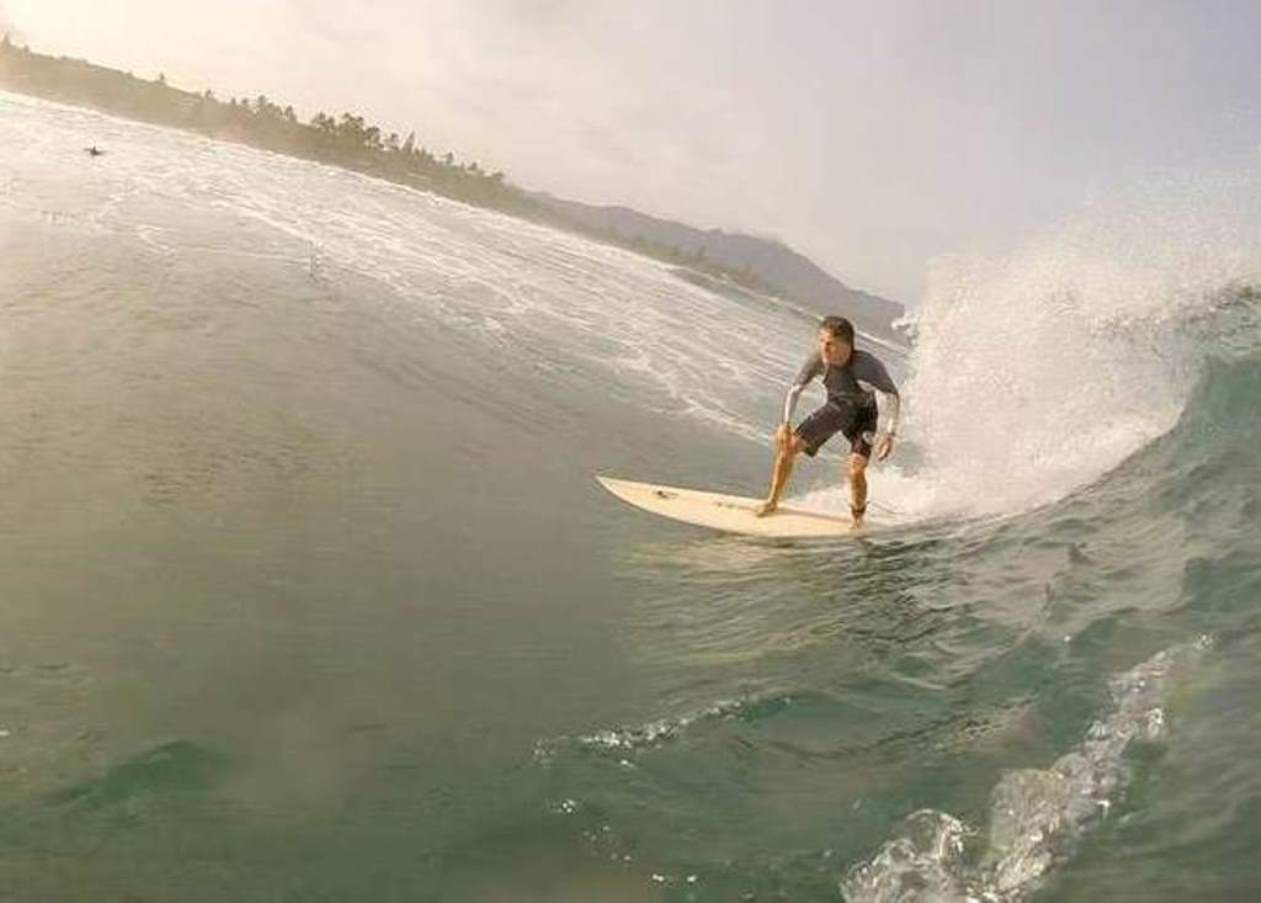
Don Piburn; northwest swell at Jocko’s on Oahu’s North Shore in 2016. (Photo: John Galera)
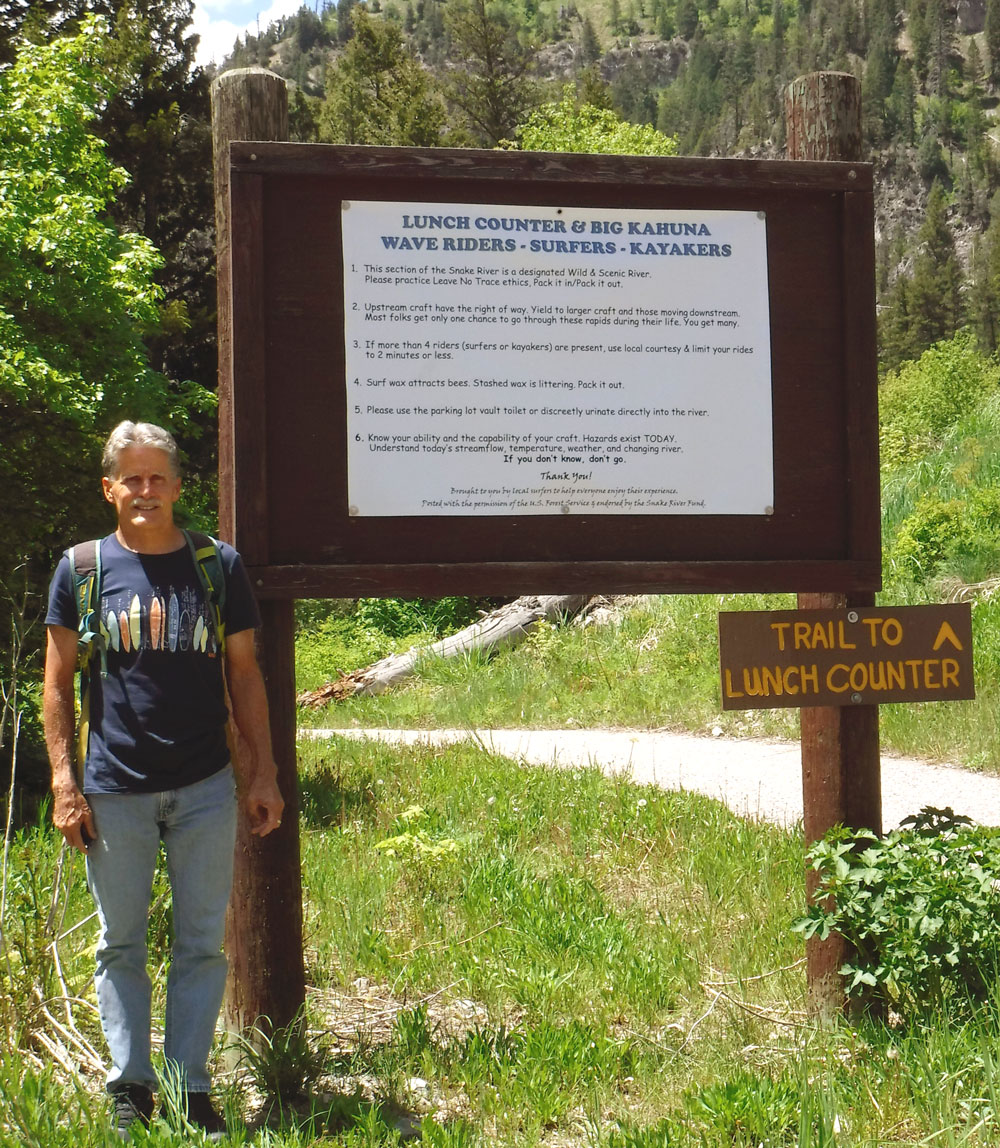
Don Piburn at the trailhead to Lunch Counter and Big Kahuna rapids. Don P. and Seal Morgan attempted a foray to surf there in June of 2019, but an eleventh-hour warm-snap pushed river levels beyond its 15,000 cfs upper limit. (Photo: Don Piburn)
-
Jacob Kelly
-
capt ardy
-
Via De Agua
-
Kirsten Haugen
-
seal morgan

